

THE LANTERN Fall Housing Edition
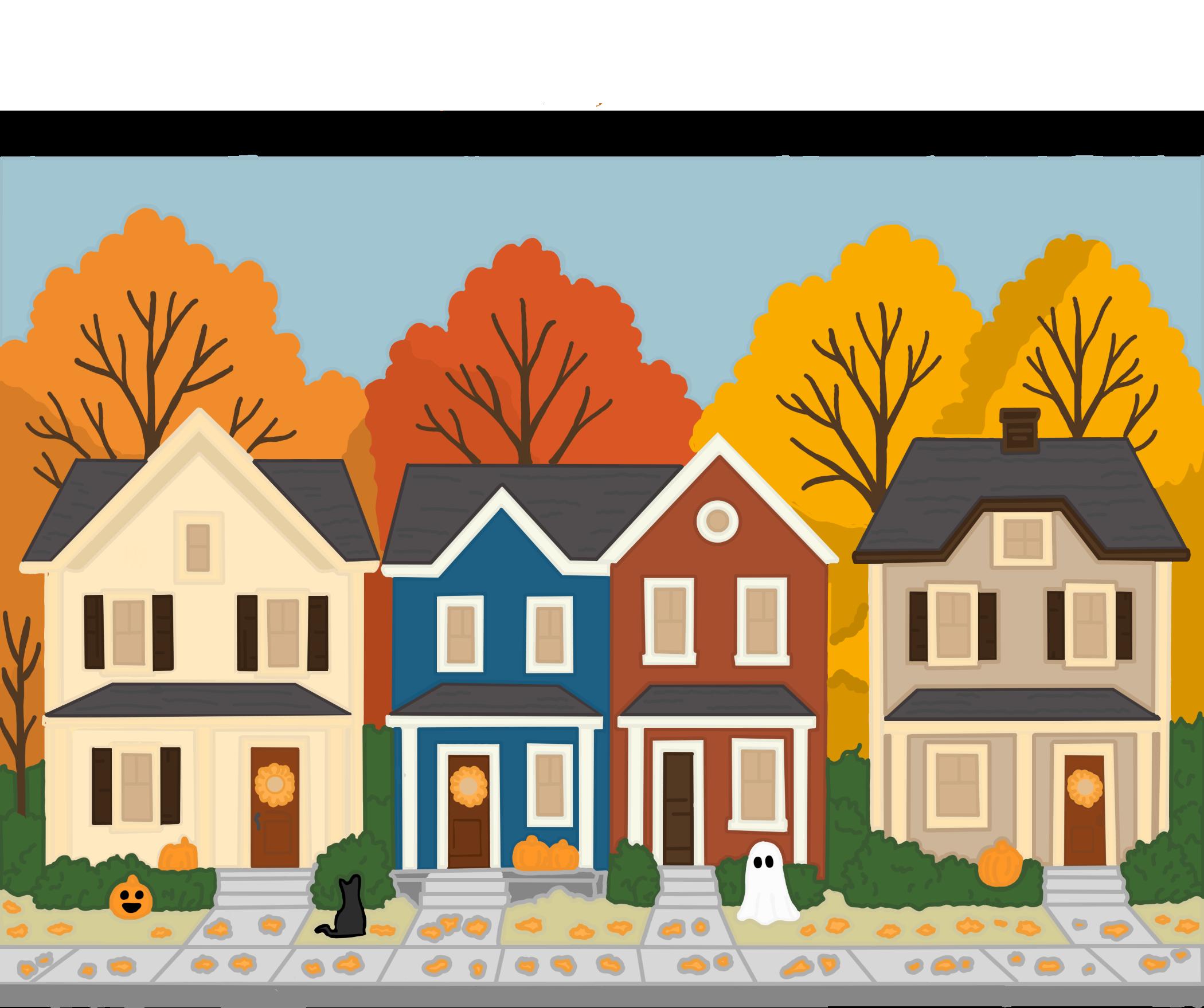


CAMPUS
On page 4
Student Legal Services
On page 7
Campus safety resources
On page 7
What to know before signing a lease
The perks of living off-campus: What makes each district unique
Julia Hart Arts & Life Senior Writer
Ohio State students have plenty of choices when it comes to off-campus living. Each neighborhood offers its own personality and perks. From art-filled streets to historic charm, different areas around campus have varying convenience, culture and community.
Short North
Known as the heart of Columbus’ art scene, the Short North Arts District south of campus is filled with creative energy. According to the Short North’s website, galleries line High Street, and the monthly Gallery Hop draws crowds to see local artists, musicians and performers.
Beyond the art, the neighborhood has become one of the city’s top dining destinations, with everything from upscale restaurants and cocktail lounges to late-night pizza spots and coffee shops.
For Kiara Corona, a fourth-year in human development and family science, living in the Short North made sense both financially and logistically when she transferred to Ohio State.
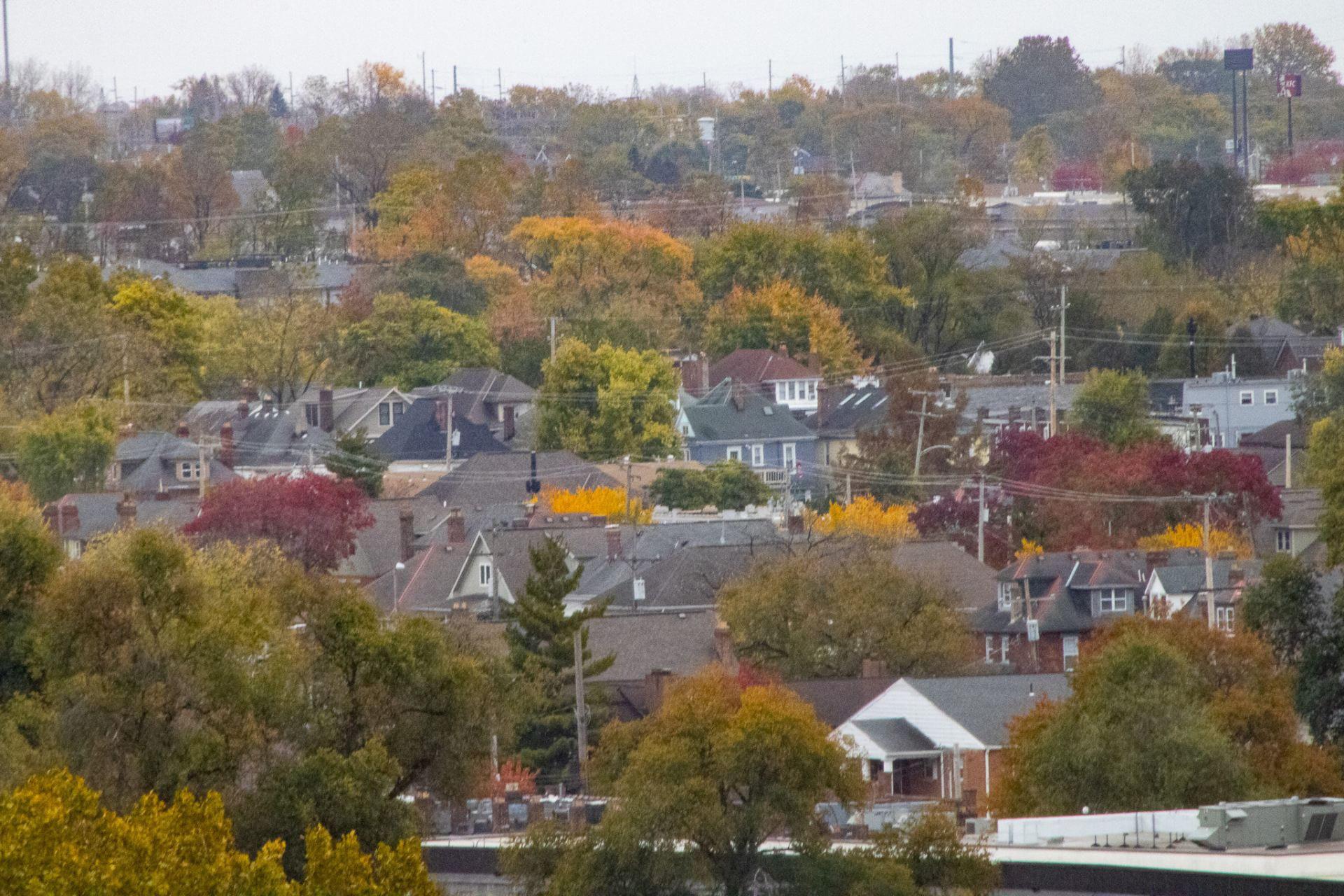
“Short North is gorgeous, especially the closer you get to Neil Avenue,” Corona said. “It’s very lively and is only a slightly older crowd than who you’d see on campus, so it’s an amazing neighborhood for upperclassmen.”
Corona said she enjoys how safe and peaceful her area feels but noted that transportation can be tricky at times.
“It does get way more difficult to get to campus when there’s lots of traffic, especially on game days,” Corona said. “Lyfts get very expensive, and parking can also be tricky whenever I have visitors.”
Corona said she drives to class but that there are several transportation options available for students who don’t have a car.
“I usually drive to campus, which takes me five to 10 minutes depending on where I’m going and traffic,” Corona said. “But if someone doesn’t have a car, the walk to campus is about 45 minutes and truly isn’t bad at all. I’ve made the walk several times. There are also so many [public bus] stops in Short North for people who use public transportation, as well as Lime scooters and bikes to rent.”
Old North Columbus
Stretching north of Lane Avenue and just beyond the University District, Old North Columbus offers a more laid-back, and often more affordable, living option for students. The area is known for its mix of longtime residents, artists and students, creating a diverse and welcoming neighborhood.
According to Old North’s website, the area’s walkability makes it easy to get around without a car, with plenty of local restaurants, coffee shops and music venues along High Street. Spots like Hounddog’s Pizza, the Old North Arcade and Ace of Cups are very popular, while nearby parks and historic homes give the area a cozy, community feel that’s just far enough from campus to feel separate but still close to the action.
OFF-CAMPUS DISTRICTS continues on page 12.
Off-campus homes in the University District on Wednesday.
DANIEL BUSH | CAMPUS PHOTO EDITOR
Advice from seasoned house hunters: A guide for first-time renters, from those who’ve done it
Lauren Savitsky Lantern Reporter
Ohio State’s largest sophomore class, of 9,530 students, is feeling pressure to secure leases for the 2026-27 school year, and with limited off-campus housing options, students said securing housing early is the key to managing rent costs, roommate choices and amenities.
The two-year on-campus housing requirement for this class ends next fall, so time is of the essence when it comes to signing a lease for next year.
Choices range from houses and traditional apartments to newer luxury complexes. Rents span from about $600 a month per person for houses to nearly $2,000 per person for luxury units with upgraded amenities, comparing prices from student rental companies and apartments in the area. Houses often hold large groups, with some offering up to nine bedrooms.
“Living in a house is chaotic, but it’s kind of fun at the same time,” Paige Sommerfeld, a third-year in health sciences, said.
Sommerfeld said she wishes she had known more about housing options when she was a second-year.
“I love living in a house with my friends, but I wish I knew there were more options out there than just the first one I stumbled on,” Sommerfeld said.
Some students, like Akasha Lancaster, a fourth-year in psychology, said a traditional apartment with affordable rent is the best choice.
“Having a more affordable rent allows me to save for other things and also helps in a way with my academics,” Lancaster said. “I don’t have to spend as much time at work to pay for things and can focus on homework and studying.”
With a similar living-style, luxury units have amenities like fitness centers, pools or cafés but can greatly increase living expenses.
Other students claim that living in luxury apartments is the way to go.
Greta Gross, a third-year in finance, said when she was looking for housing she wanted a place where she and her roommates felt safe and was convenient to campus.
Gross currently lives in the Rambler at 222 W. Lane Ave.
“All the amenities this place offers is so nice,” Gross said. “We also knew if we were going to do an apartment, we wanted it to be furnished and this was just a good fit.”
Gross said she advises second-years to start the housing search early.
“My advice would be to start the day you get here,” Gross said. “Make sure you know what group you want to live with because finding housing is one thing –knowing how many people is even harder.”
Lancaster said something similar, advising that time is paramount for finding what fits your lifestyle best.
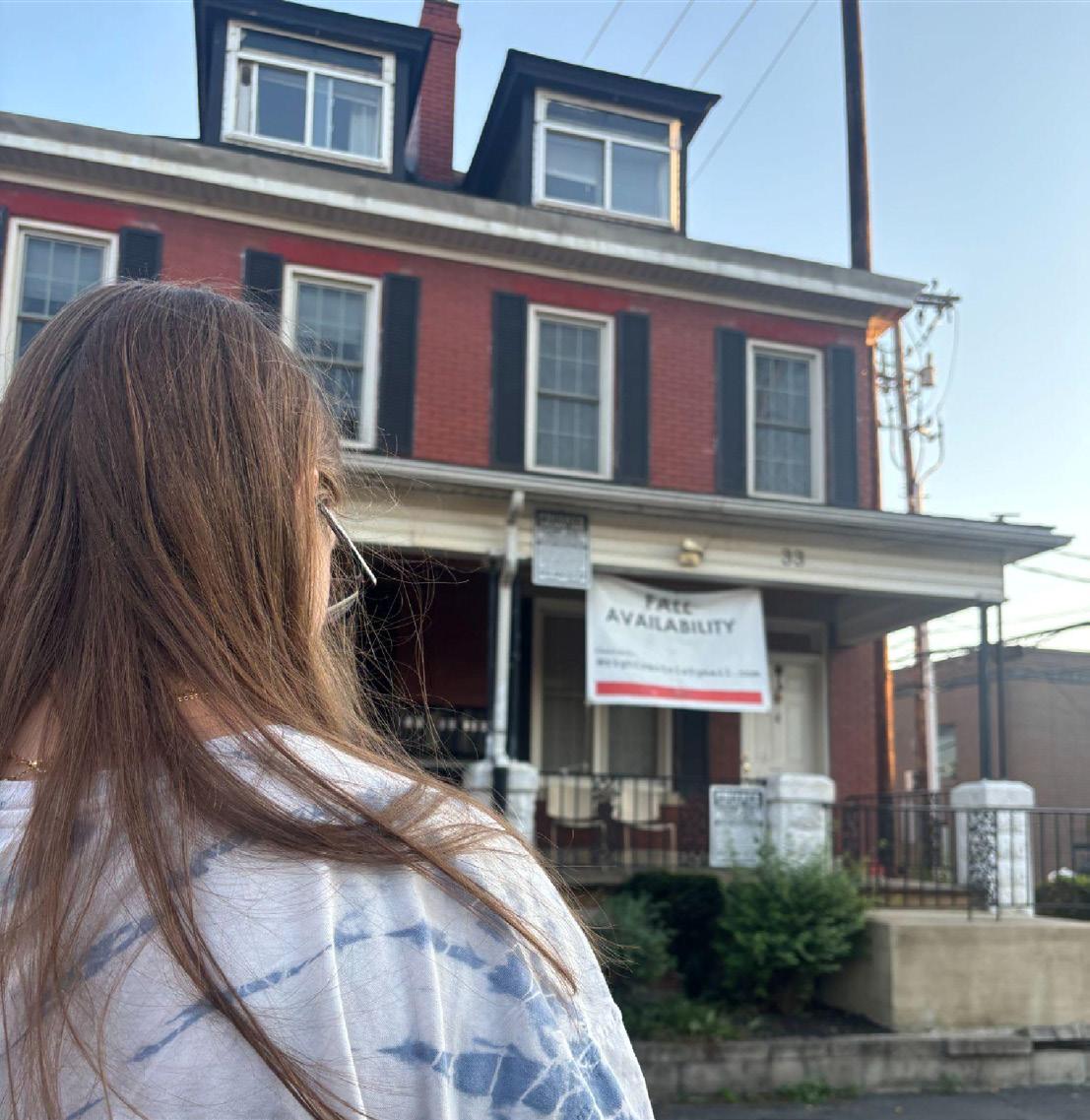
An Ohio State student stands outside off-campus housing advertising fall availability Sept. 14, 2025, in Columbus, Ohio.
“I wish I knew to start almost a year ahead of time to have the most amount of options,” Lancaster said.
Sommerfeld, however, said her advice is to not settle for the first option and to not panic if others sign leases before you.
“You have more time than you think, even if it doesn’t feel that way now,” Sommerfeld said.
Comparing on- and off-campus living: What’s best?
Ally Wolfe Campus Senior Writer
Throughout a student’s college career, a variety of living options will be available. From a central dorm surrounded by dining halls and lecture buildings, to apartments with various amenities and standard houses off campus, different living situations can make college feel like home. Here is how on- and off-campus living compares. For students who live on campus, amenities like Wi-Fi, meal plans, community lounges and proximity could mean all the difference. However, not all dorms are the same.
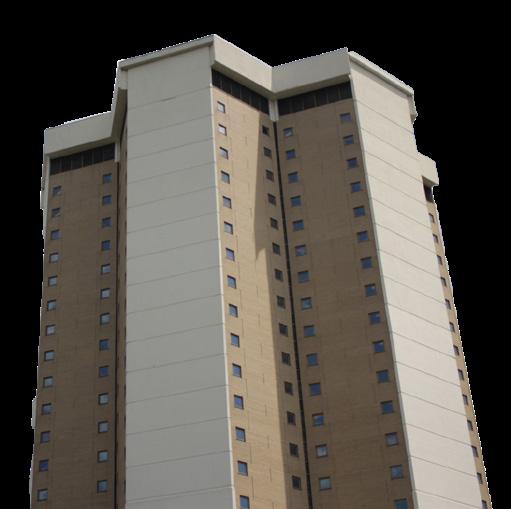
Ava Judy, a second-year in marketing, has had the opportunity to live in two drastically different dorms on campus: Morrill Tower and Busch House.
“[Morrill is] definitely packed with hundreds of freshmen, and there is a kitchen, but it was never clean,” Judy said. “There’s multiple study lounges, which were nice, but a lot of students just left their trash there.”
While Judy said she loves living in the dorm because of the convenience and proximity of her classes, dining halls and gyms, she also sees the obstacles.
“Your spaces are very small,” Judy said. “You share a room with one other person. And I think that also can be difficult at times.”
There is a two-year requirement for students to live on-campus. Once they are upperclassmen, students typically seek off-campus housing and look forward to the extra space that provides.
AMENITIES continues on page 5.
How Student Legal Services can help students navigate their off-campus living
Xiyonne McCullough Miller Special Projects Reporter
Transitioning to off-campus living can be exciting — until you’re handed a fine after forgetting to clean up from an outdoor party.
As students start signing leases for the next academic year, many are learning that moving off campus comes with new responsibilities, and potential penalties if they’re not careful.
Living off-campus gives students more freedom, but also more responsibility. From understanding lease terms, to following city codes, small oversights can quickly turn into costly mistakes.
To stay out of trouble, Frank Kremer, chief counsel for the civil team at Student Legal Services, said students should start by reviewing their lease in full, not just the first page.
“Always check all the fill-in-the-blank spots on leases,” Kremer said. “Dates, dollar amounts, which utilities you’re obligated to pay, parking costs: anything that might vary from lease to lease.”
Beyond understanding the lease itself, students need to know their responsibilities within the household. Kremer advised students to clarify how financial and legal obligations divide among who they live with.
Kremer said that if you have roommates, you need to understand if it’s a joint or individual lease. If it’s a joint lease, you share financial responsibility for rent and utilities, and if it’s an individual lease, obligations are separate.


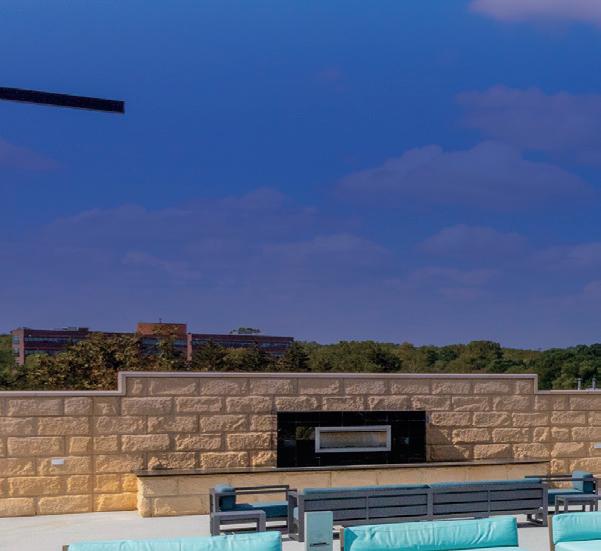

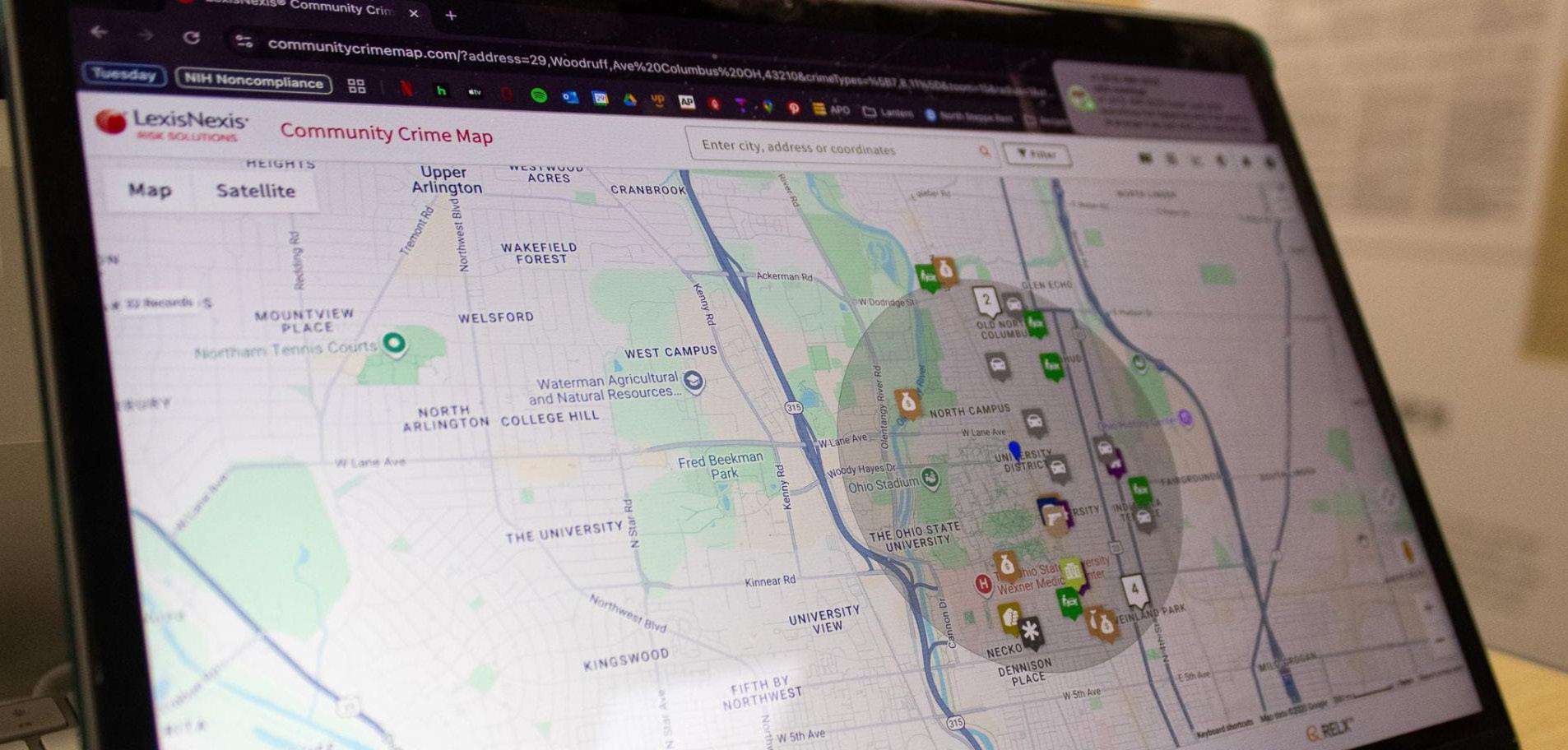
The Community Crime Map on Wednesday.
For some students, those lessons come only after running into a housing issue.
STUDENT LEGAL SERVICES continue on page 10.

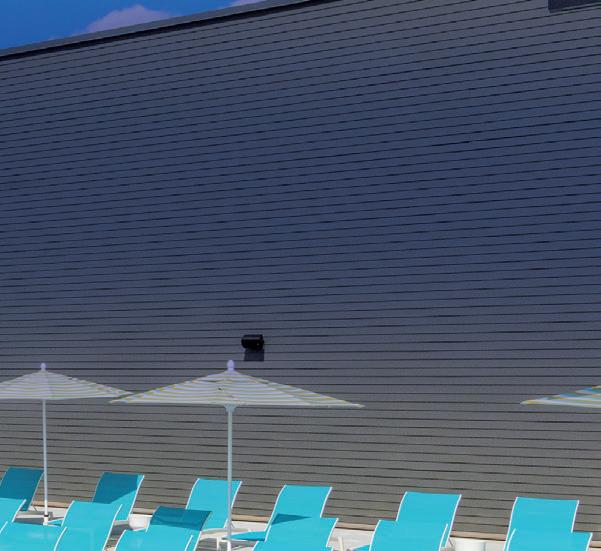
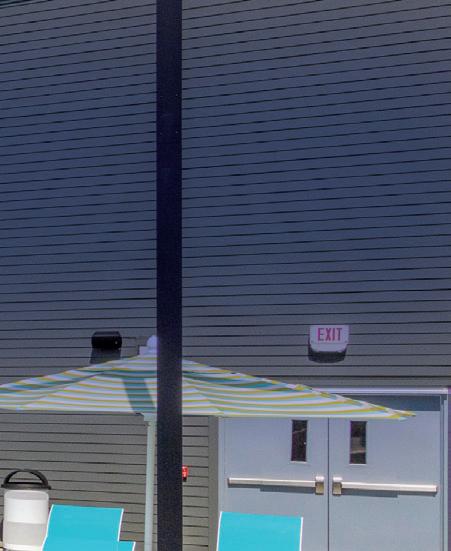
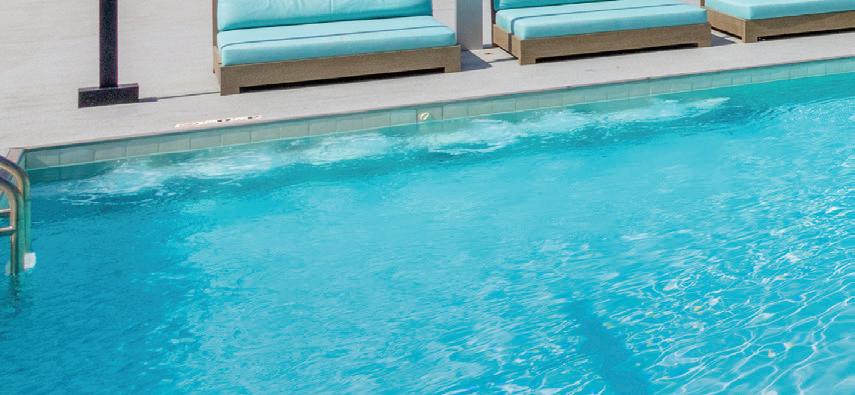
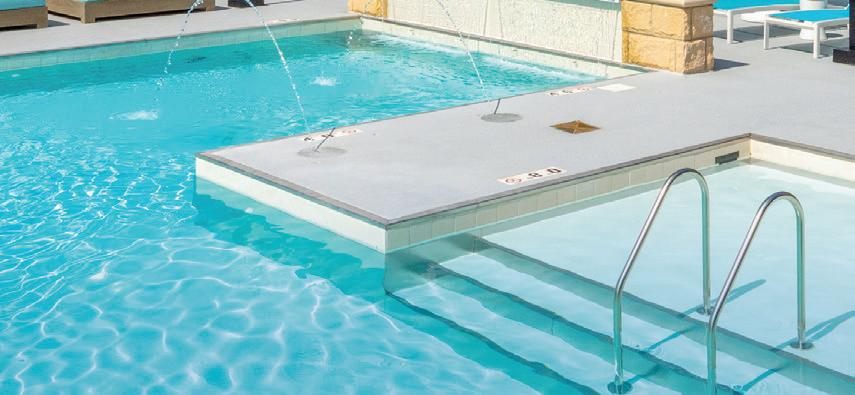
UPGRADED
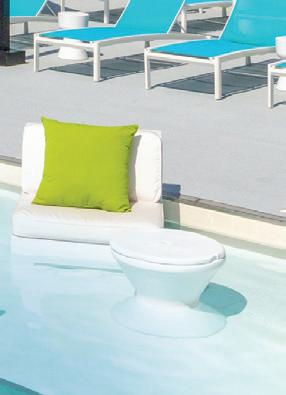
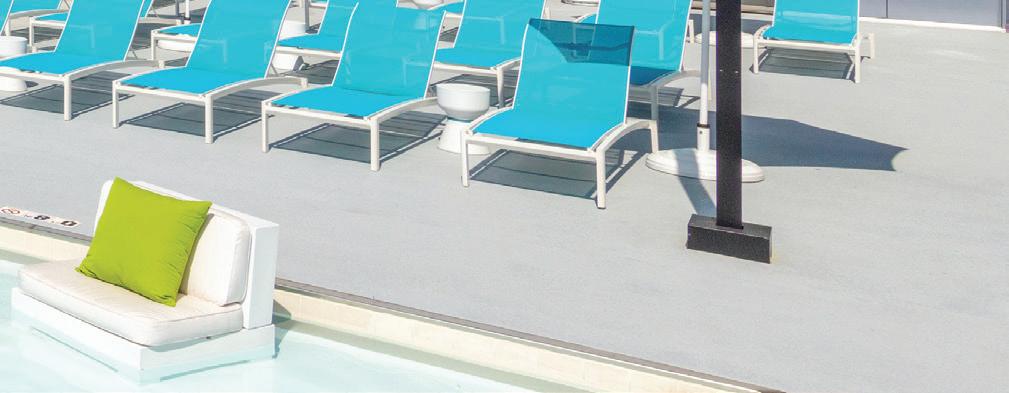

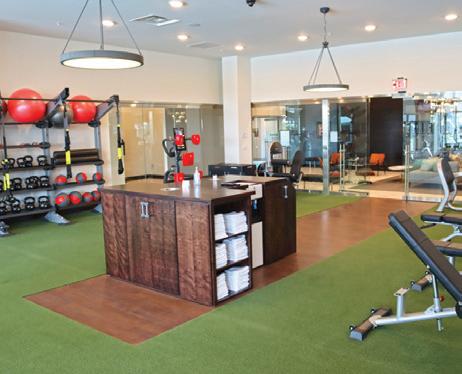
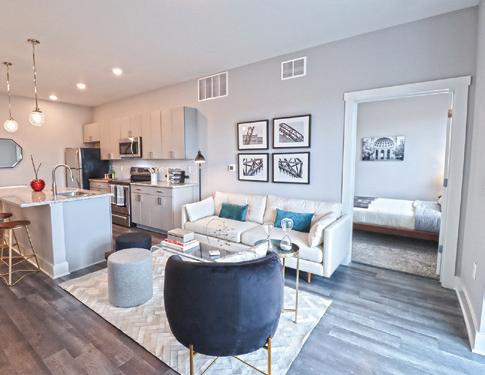
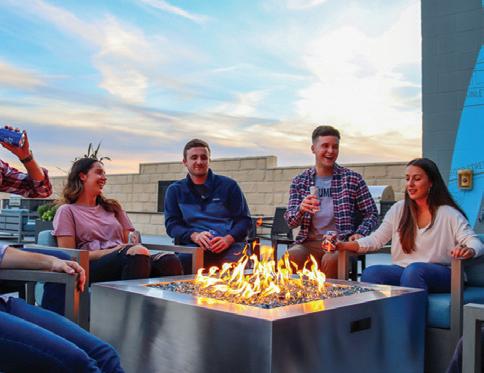


DANIEL BUSH | CAMPUS PHOTO EDITOR
Off-campus versus on: what’s the difference?
Continued from page 3.
Kelsey Vollrath, a third-year in marketing, lived in dorms for the past two years and is enjoying her current living situation in a house.
“The more space you have to yourself and how you can [also] have people over whenever,” Vollrath said. “You’ve got your own room, your own backyard. I 100-percent love it.”
Vollrath said when compared to living in a dorm, amenities like having a living room, more space for herself and easier access to do laundry has made all the difference.
“I just walk down one set of stairs [to do laundry] instead of waiting
laundry,” Judy said.
While off-campus living may seem scary, distancing and grown-up, Vollrath feels the independence — and the responsibility — is worth it.
“You feel [independent] in the dorms because you’re new to college,” Vollrath said. “Then moving to the house, you feel it even more because you have to pay for your rent, buy your food, find time to cook for your food, you’re just on your own, even more.”
Vollrath said above all, the extra advantages and amenities, whether on- or off-campus, living with her friends and being able to just coexist with them is the best part.
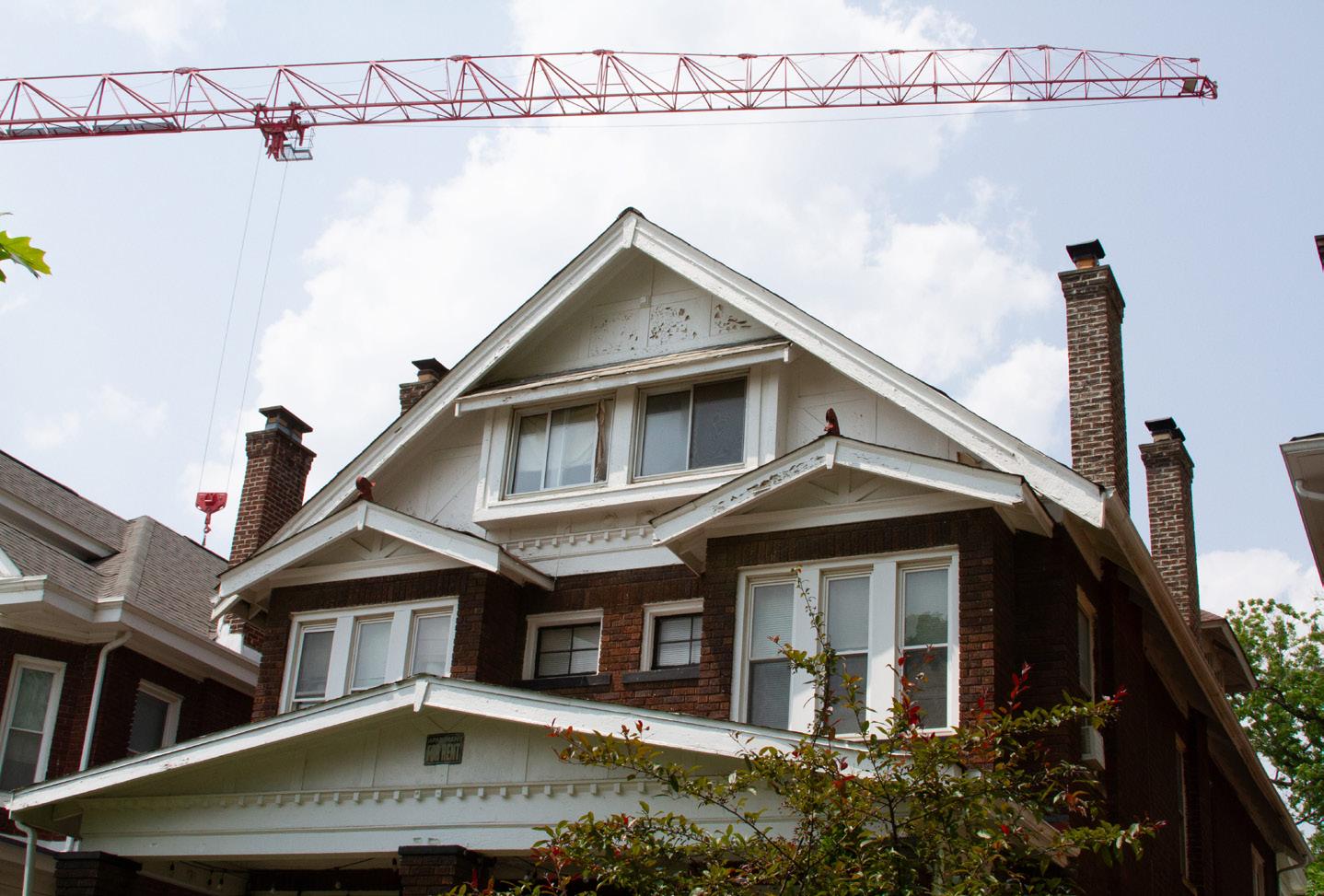
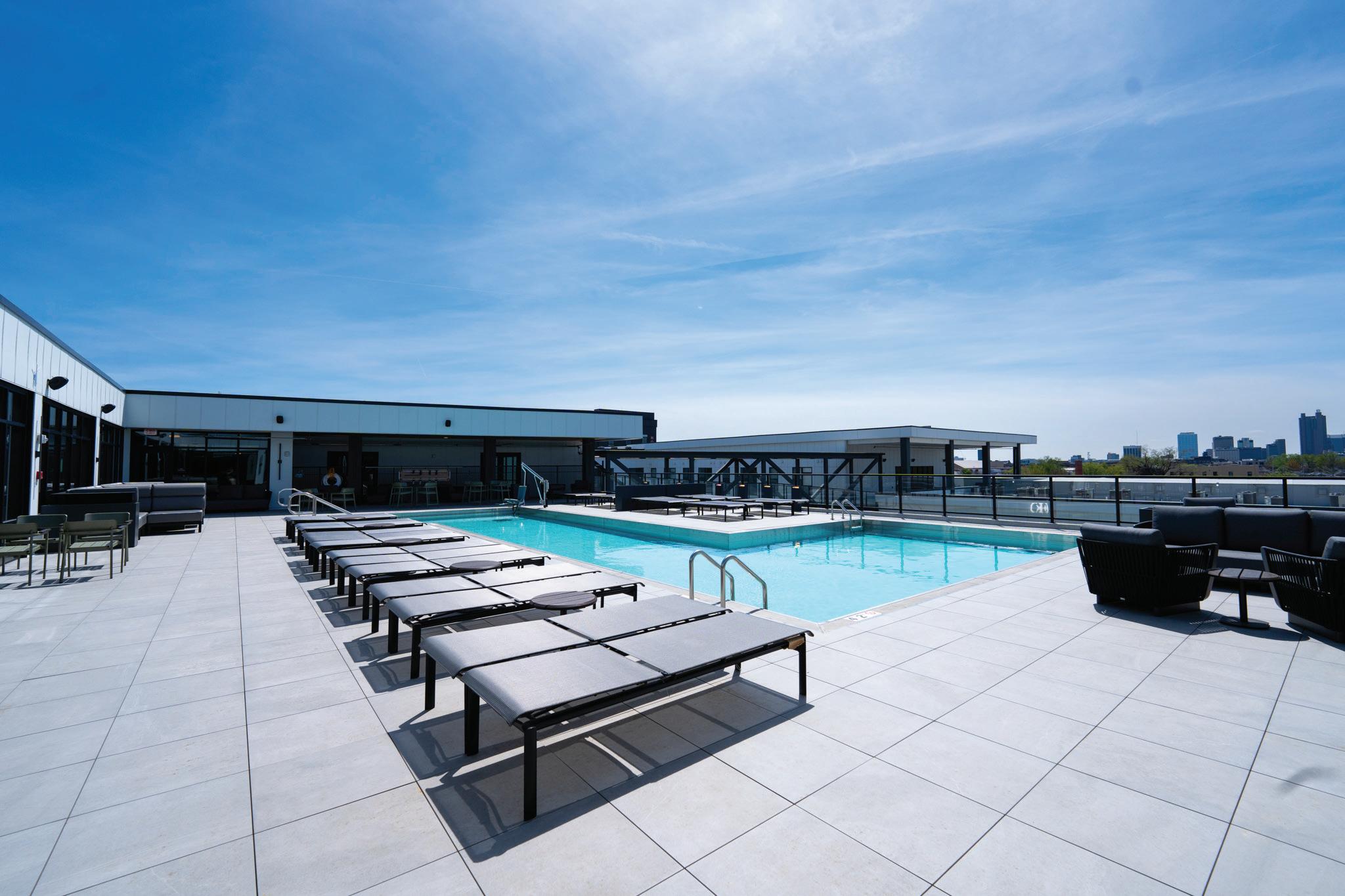

hours,” Vollrath said. “I don’t have to wait on a washer.”
Even though all the other dorms have readily available laundry rooms, Judy echoed the excitement for a new laundry system when living off-campus next year, especially one that doesn’t involve strangers.
“Some people don’t set a timer, and some people do, and if you’re not exactly on it, people just throw your
“I’m living with all of my best friends, like, I got to pick them,” Vollrath said. “We’re all in the place, I can walk down the hallway and be right there.”
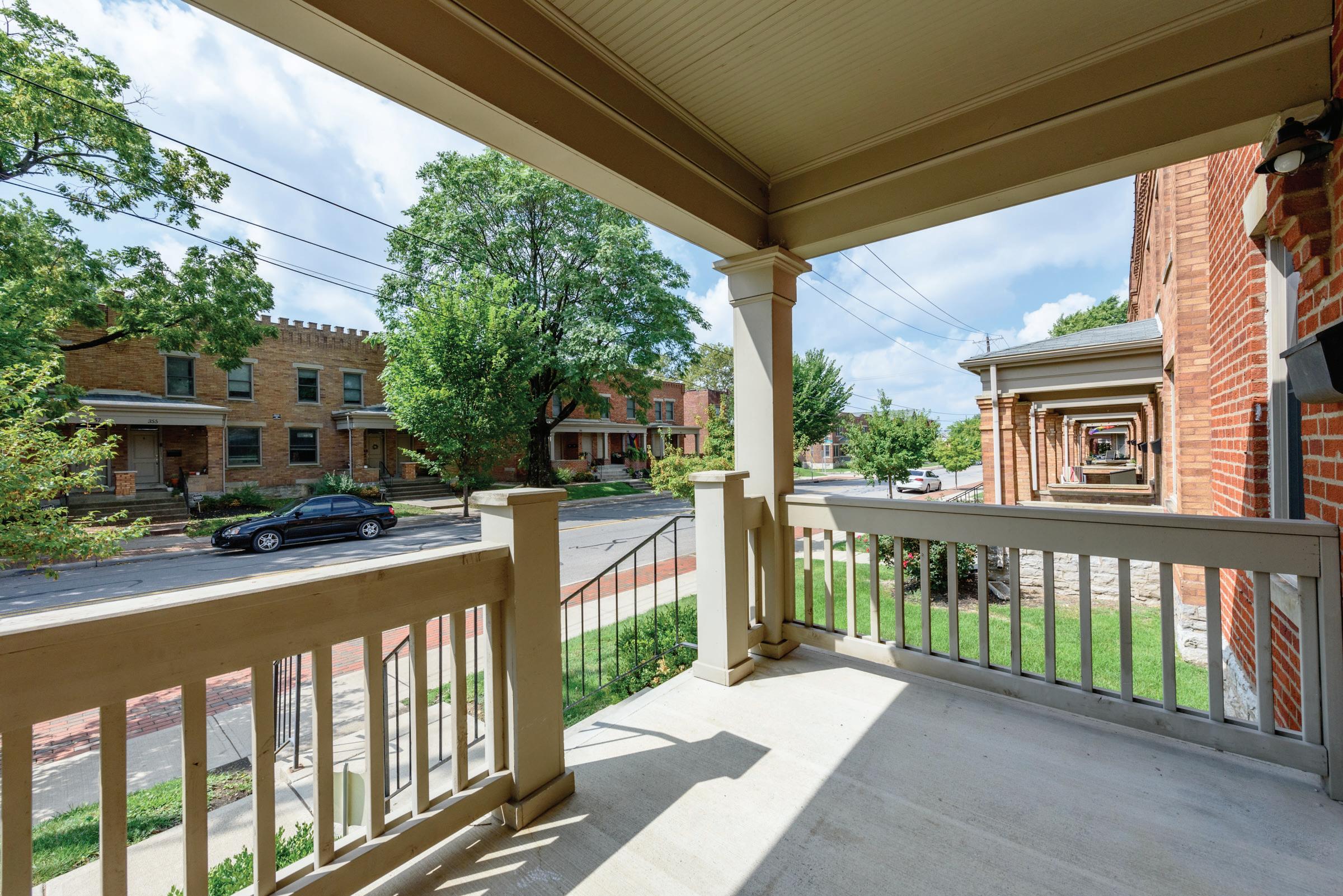

108-110 E. 16th Avenue sits in the shadow of a nearby apartment construction project.
DANIEL BUSH | CAMPUS PHOTO EDITOR



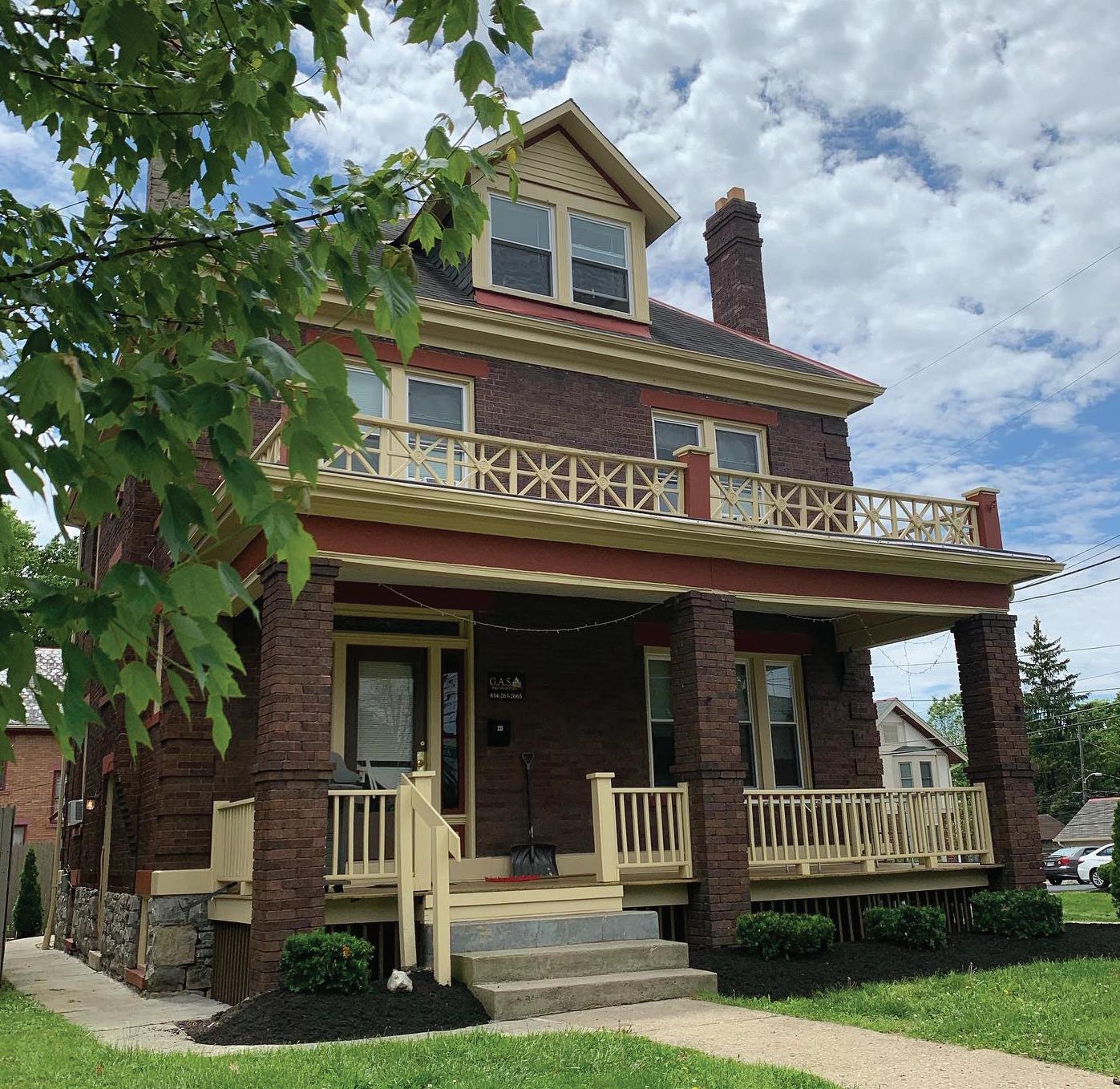
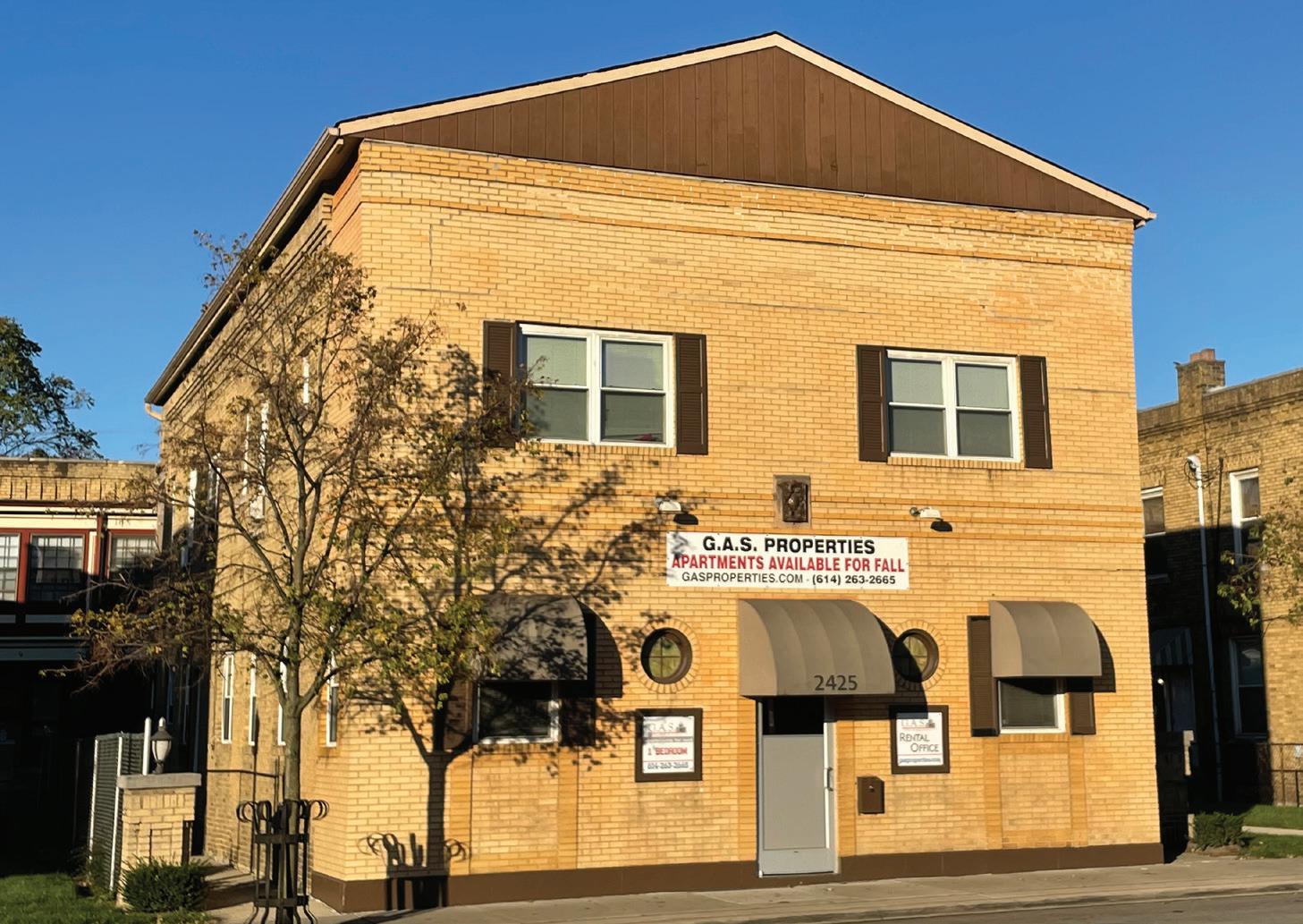
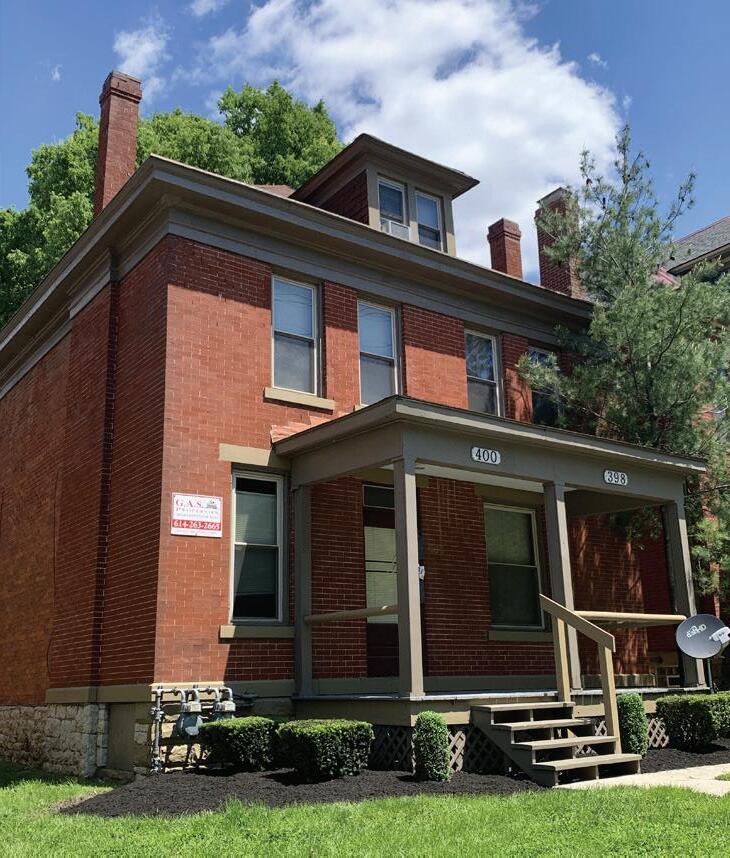
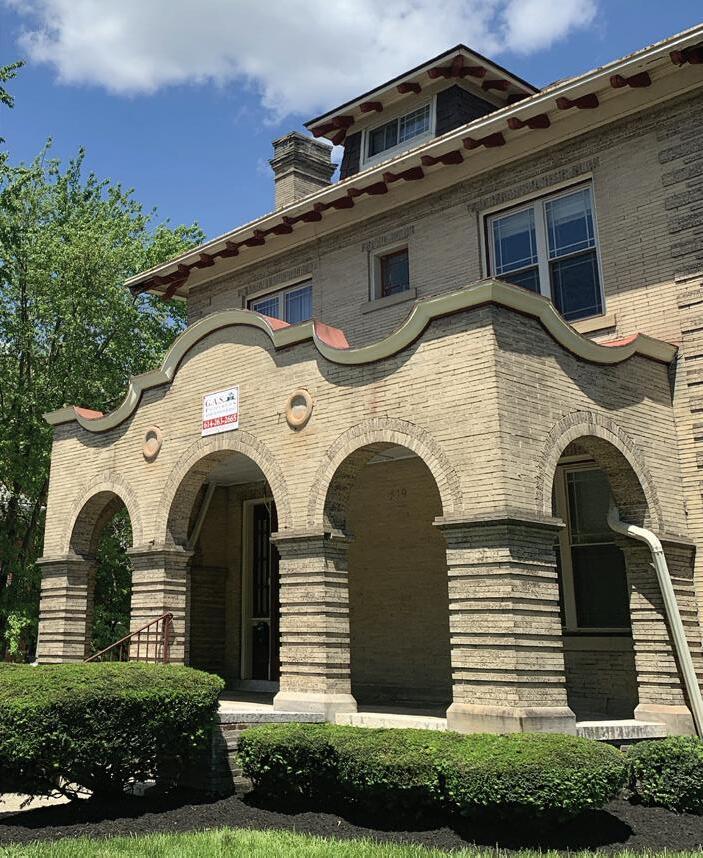
Staying Safe Beyond Campus: resources for off-campus student safety
Mariam Abaza
LTV Special Projects Producer
Thousands of Ohio State students live in apartments and houses off-campus, and for many, safety remains an area of concern.
From protection on late-night walks to security devices for apartment windows, the university offers a range of resources at low to no-cost to help students feel secure while living off-campus.
“Our top priority is the safety of our campus community and we understand a majority of our students live in the immediate off-campus area,” Dan Hedman, a university spokesperson, said in an email.
Here is what Ohio State offers.
Public safety patrols off-campus
The University Police and Columbus Division of Police work together to patrol areas surrounding campus.
Joint patrols between the two departments began in 2008 as part of a mutual aid agreement that allows Ohio State police to have jurisdiction in off-campus properties in certain circumstances, Hedman said.
This partnership has grown to fit the constantly evolving safety needs of the Ohio State community, with consistent expansion of resources and staffing, Hedman said.
“We work closely with the Columbus Division of Police (CPD) to exchange information and assess crime trends. Major off-campus crimes dropped significantly since the initiation of our enhanced resources in fall 2021,” the Department of Public Safety said on its webpage.
In 2022, the program expanded from one patrol car to four based on an independent report recommending off-campus safety measures, per prior Lantern reporting.
Personal safety devices and tools
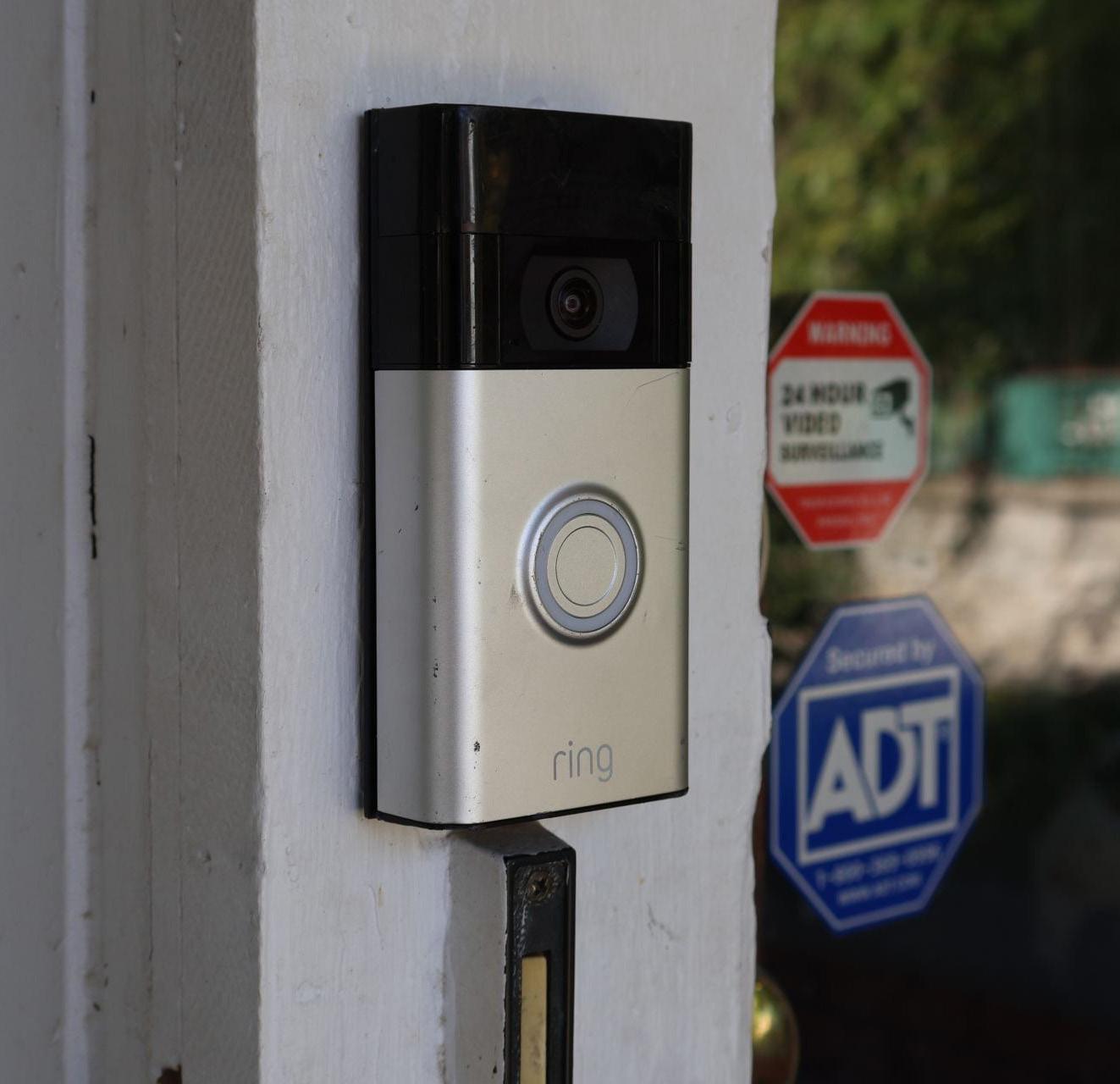
The university also provides tools for personal safety. The Willie J. Young Sr. Off-Campus and Commuter Student Engagement Department, found on the third floor of the Ohio Union, provides free resources, safety tips and safety devices according to its website.
The department offers complimentary window-attachable safety alarms that emit a loud noise when triggered to deter potential intruders.
“We know that burglars are criminals of opportunity, so if they can come in and take things from an empty house where the lights aren’t on and no one is around and there are no security features, they’re far more likely to do that and more likely to be deterred
if as they, let’s say, open a window, they hear that loud piercing noise,” Dave Isaacs, a university spokesperson, said. “It’s a known deterrent to crime.”
Students can also pick up a free personal safety alarm, which can be used to repel aggressors.
“If you pull the tab, it emits a very loud, piercing noise and lets people who are around or near you know that something is amiss,” Isaacs said. “It will help deter and drive away those who may intend on making you a victim.”
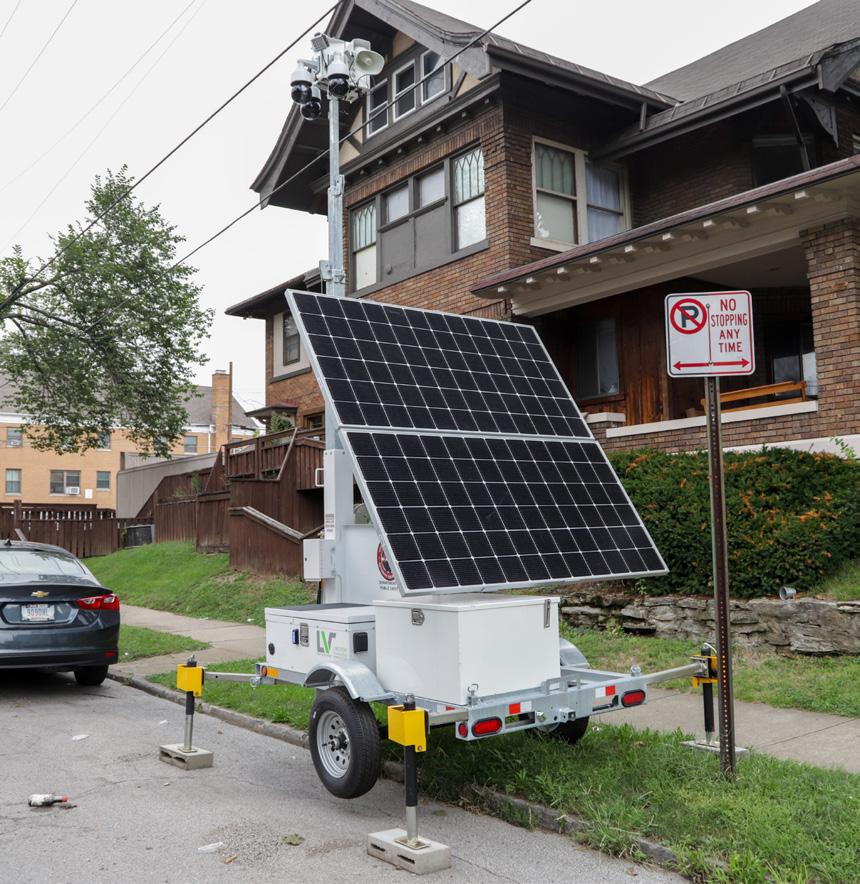
Safety cameras around campus are one resource Ohio State uses to increase safety.
For added protection, students can download the Rave Guardian application to enable GPS tracking for select contacts. The app uses a destination-based timer to alert selected contacts if the user fails to arrive at a specified location, according to the Department of Public Safety website.
University-provided safety resources
Ohio State provides safety training modules, bus and rideshare programming and interactive informational resources to help students stay safe.
The Department of Public Safety and Columbus Division of Police created a self-defense and safety promotion online course called Stay Safe, Buckeyes. The class is available each year, Hedman said.
Additionally, the university offers discounted rides to the Short North area along High Street through the Lyft Ride Smart Program, which offers a $4 discount to students using the rideshare application between 7 p.m. and 7 a.m., according to the Department of Public Safety page.
The Campus Area Bus Service also provides free transportation around campus, according to the CABS website. CABS On-Demand extends service to areas west of the Olentangy River and select campus stops for added convenience and safety.
Students can also monitor on-campus crime through The Department of Public Safety’s daily crime log. For the surrounding area, the community crime map collects data from Columbus police within a mile radius from campus.
Tips for staying safe while off-campus
Students are also recommended to exhibit general safety measures while living off-campus.
“Always lock doors and windows at home, do not leave valuables, keys, or key fobs in your vehicle,” Hedman said. “Avoid walking alone, especially at night, and report suspicious activity, missing or stolen items to the police.”
If a crime occurs off-campus, students are encouraged to call 9-1-1 or the Columbus Police at 614-645-4545, Hedman said.
For more information about safety programs and resources, visit the Department of Public Safety website.
DANIEL BUSH | CAMPUS PHOTO EDITOR
Ohio State students living on Waldeck Avenue use cameras and home security systems to improve their safety in their off-campus housing.
BAILEY JOHNSTON | LANTERN FILE PHOTO


What students need to know before they sign a lease
Cameron Dewey Lantern Reporter
S
igning a lease may seem like a formality, but it is actually an important legal agreement that can have significant consequences if not fully understood.
Before signing a lease, students should be aware of the ins and outs of their lease agreement to prevent future issues.
Here’s everything students need to know before they sign their lease.
Research the landlord or leasing company
“One of the biggest mistakes students make is not giving enough time researching the landlord, taking a look [or] touring the apartment itself,” Frank Kremer, chief counsel of the civil team for Student Legal Services, said. “With the volume of information that’s available online now, it’s getting more and more common that people don’t go and visit and tour the apartments themselves.”
Strategies such as researching landlords and properties can be utilized
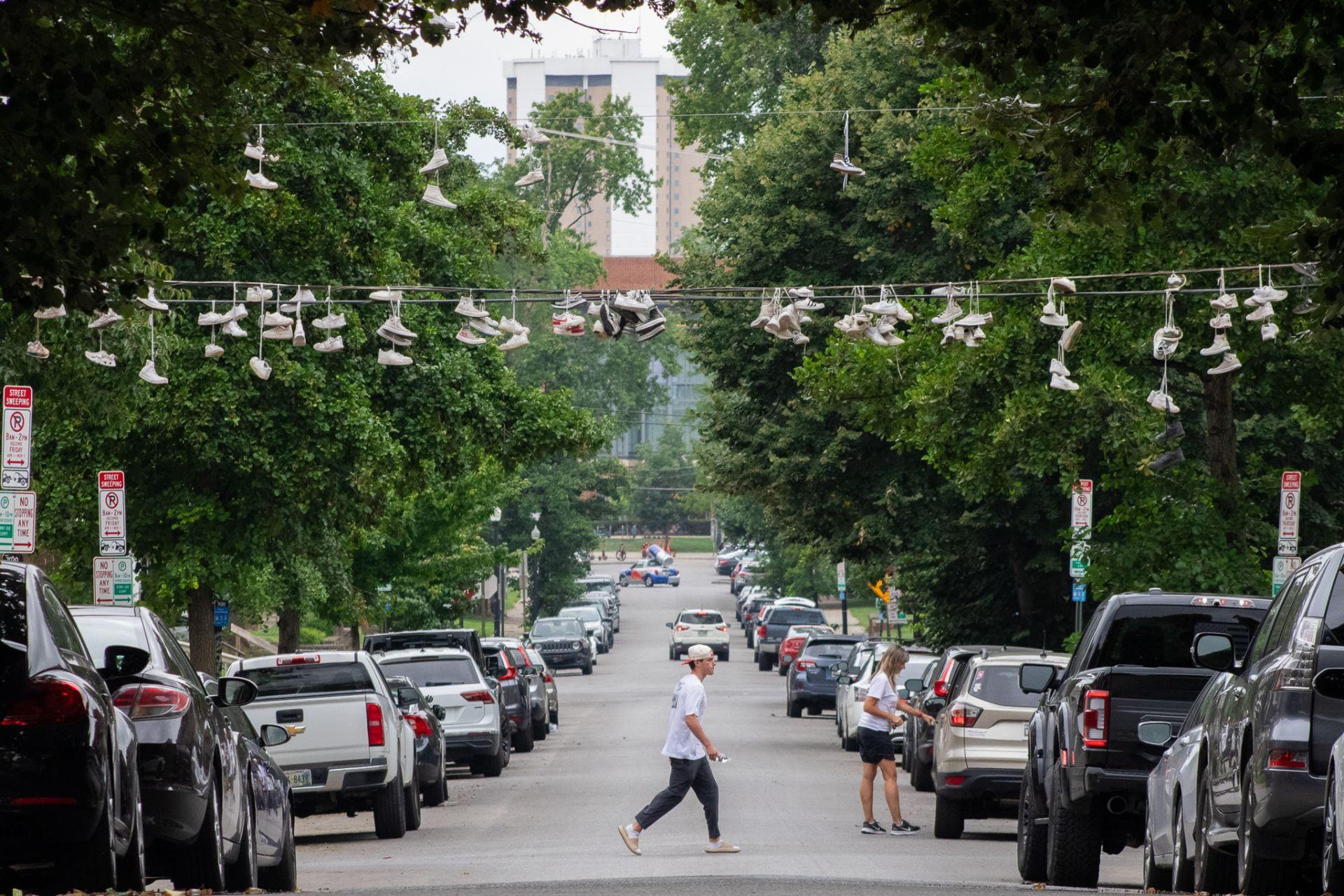
As students move into off-campus housing, reading the lease before signing can help give a clear picture on what is allowed.
through online resources, but should not replace touring the property in person, Kremer said.
Take the time to review your lease
Another mistake students make is rushing into signing their lease before they have properly reviewed it, Kremer said.
After finding a place to live for the year, students may not thoroughly read their lease before signing, eager to complete the process.
“I did not read my lease fully before moving in, but I wish I did,” Mitchell Niemantsverdiet, a third-year in psychology, said. “I didn’t really think there was a need to. I just figured if I paid rent on time, then no problem.”
LEASE continues on page 11.

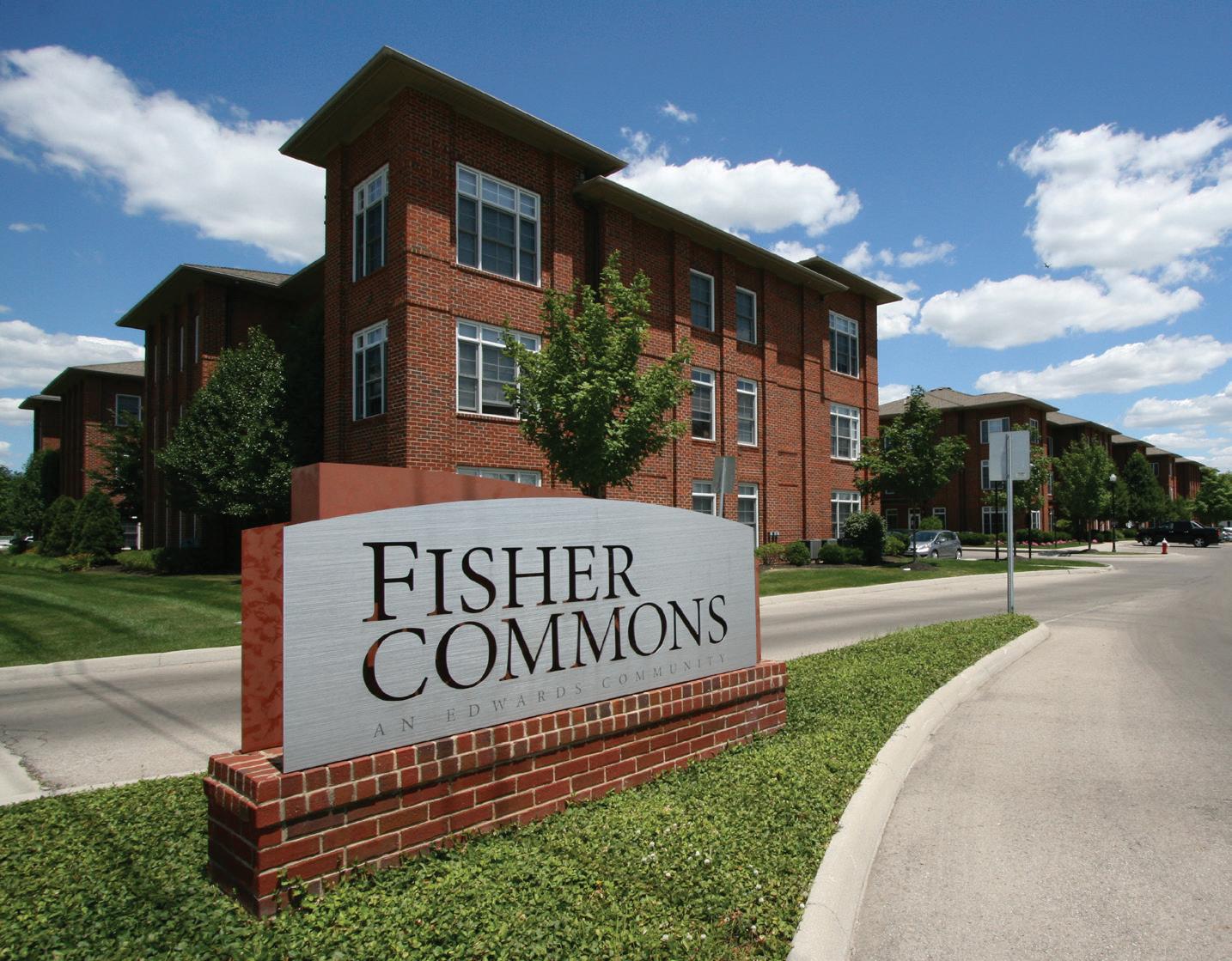
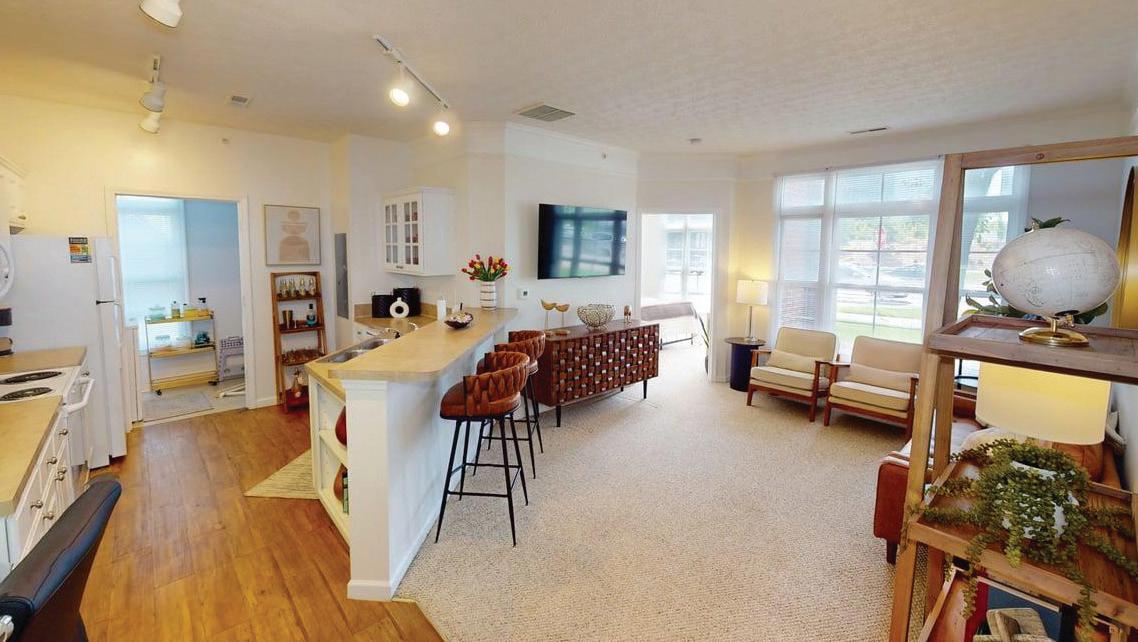
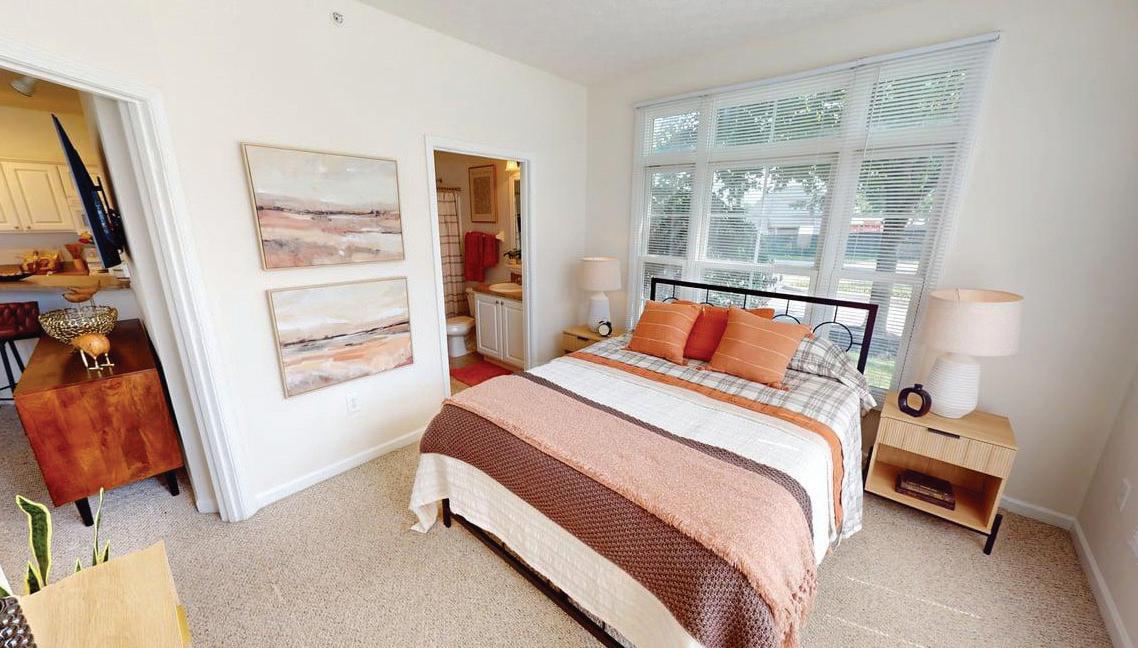
DANIEL BUSH | CAMPUS PHOTO EDITOR
VOTED BEST PLACE TO LIVE!
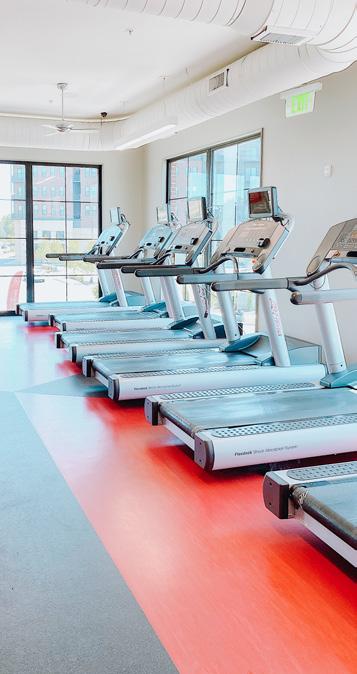
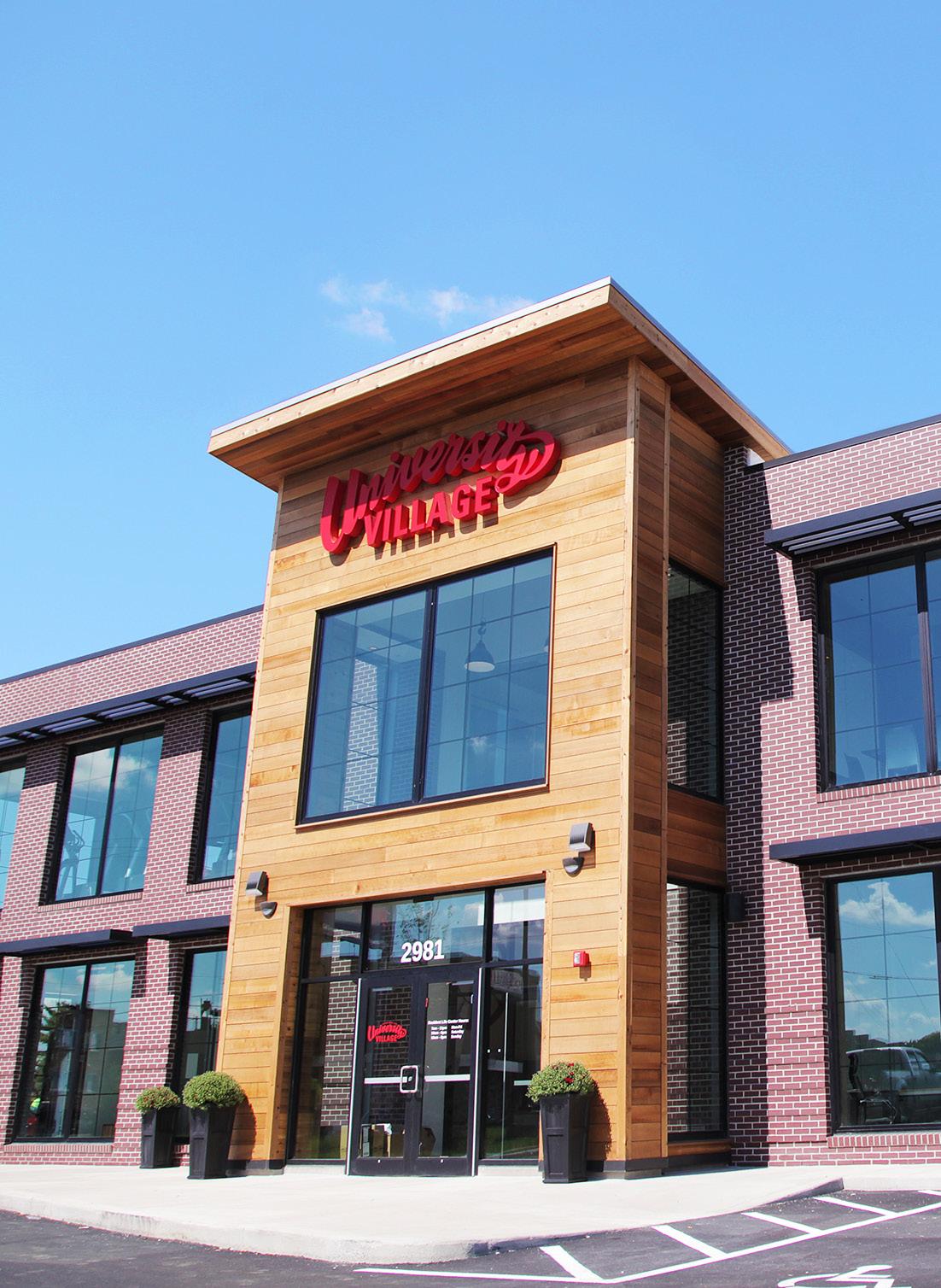
SLS resources for students
Continued from page 4.
Tiarah Thompson, a third-year in actuarial sciences, said she didn’t expect to face legal trouble, until she received a last-minute opportunity that required her to leave her lease early.
“I had signed a lease for the upcoming school year. So, I needed to break that agreement so I wouldn’t have to be in that contract to continuously pay rent,” Thompson said.
Thompson reached out to Student Legal Services to have her lease reviewed and get advice for her situation. They recommended a possible buyout or finding a subletter.
Once students arrive at their new place, Kremer said documentation is everything.
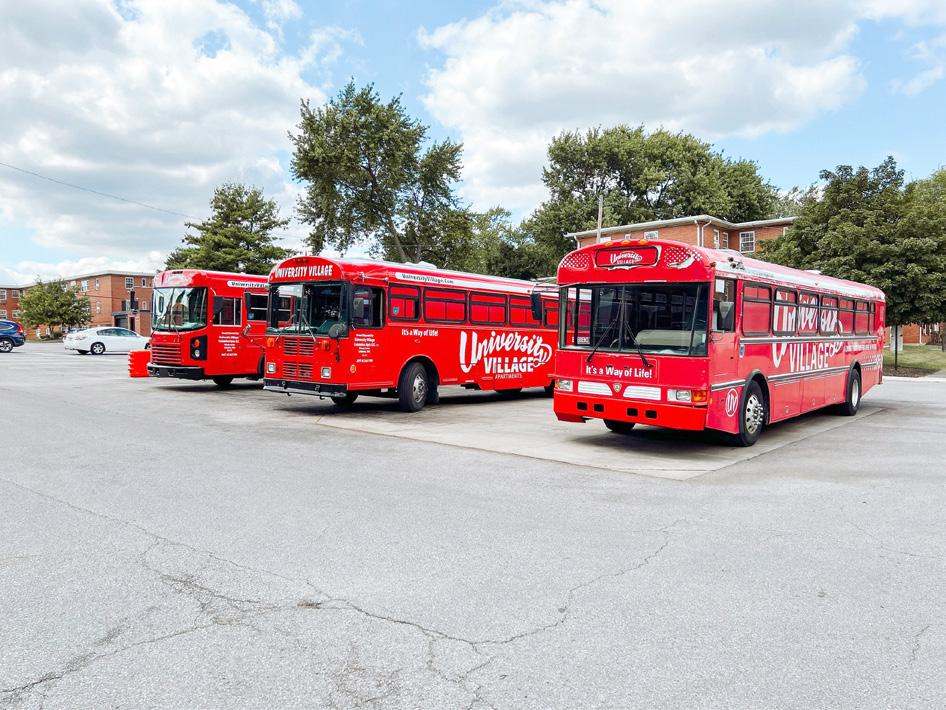
“When you’re moving into a property, take photos and videos of everything,” Kremer said. “That can help protect from security deposit disputes down the road.”
Even after move-in, off-campus living can present new challenges that go beyond the lease itself. Kremer said some legal problems students can overlook are city code violations, which tenants are responsible for knowing.
“Code violations can be assessed to the tenant,” Kremer said. “So if
there’s trash out front on the front lawn after the weekend, the city could cite the tenant for that.”
Landlords have set obligations when it comes to repairs and treating property damage.
“Landlords have a reasonable time, with a maximum of 30 days, to remedy any conditions at the property that the landlord has a legal obligation to fix,” Kremer said.
Students can be held liable if they’re not timely with reporting issues.
“If you don’t notify the landlord right away and the problem gets worse, you could be held liable for that aggravation of the problem,” Kremer said.
Thompson said that for many students, learning to manage off-campus responsibility is part of adulting.
“We’re still growing adults, and some of these things are the first time we’re experiencing them,” Thompson said. “Even reaching out to resources like SLS can feel intimidating, but just asking ‘What should I know’ is a good first step. The resources are here to help and guide you.”
Student Legal Services offers free lease reviews and legal consultations for Ohio State students. Appointments can be scheduled through the office’s website.
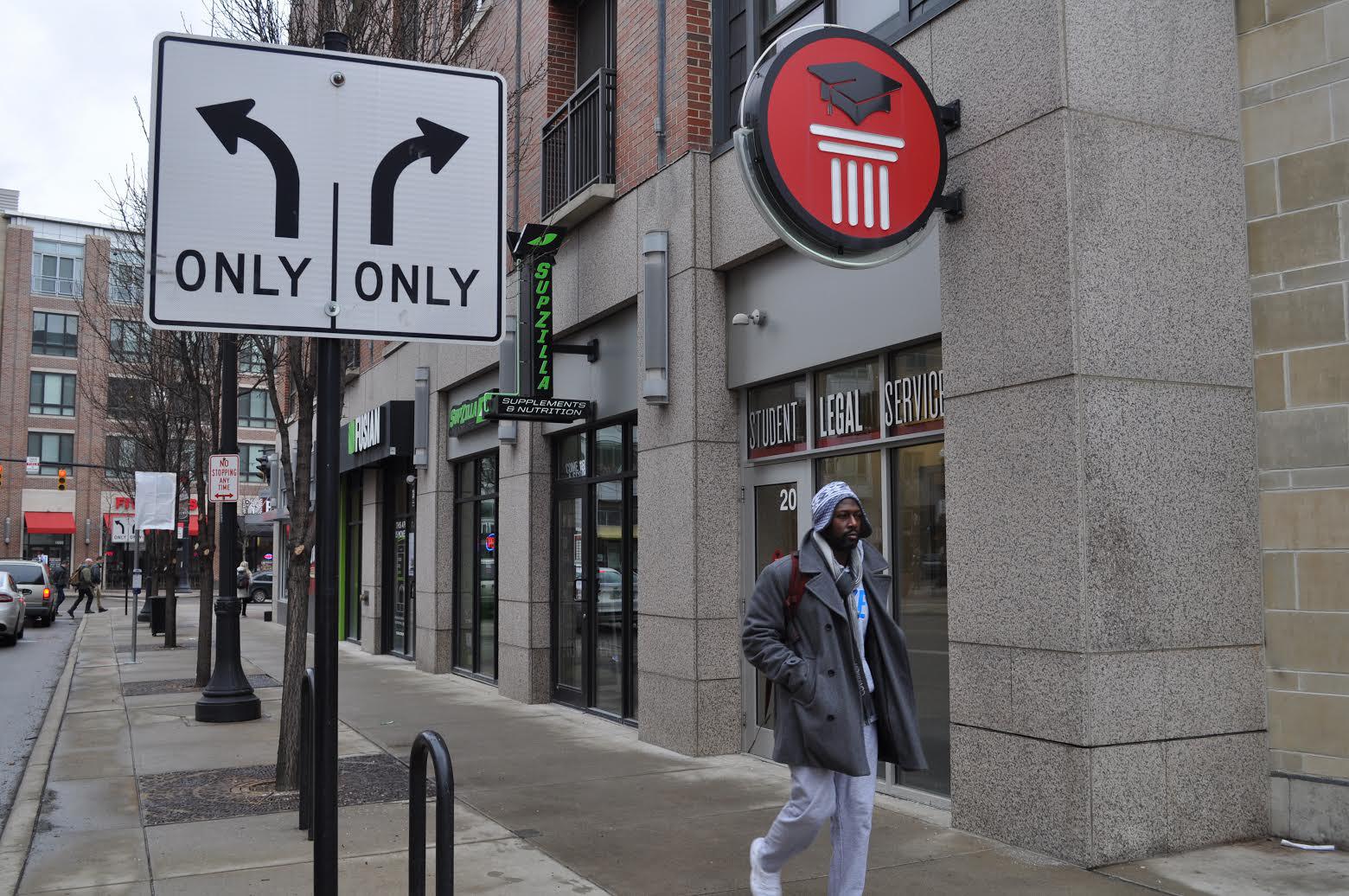
Student Legal Services is located on East 11th Avenue.
NICK ROLL | LANTERN FILE PHOTO
Lease signing 101
Continued from page 9.
Inorder to combat this, students can use Student Legal Services’ free lease reviews.
“Before students sign a lease, they can schedule an appointment with us, and then we will walk through that entire lease agreement with them,” Kremer said. “To make sure that they understand what they are signing, what their rights and obligations are, what the landlord’s rights and obligations are, the tenants’ responsibilities, etc.”
According to Kremer, the goal of legal services is to be accessible. To make these appointments, students can go to the office’s website to schedule an appointment.
“There’s a lot of stuff in a lease that you wouldn’t expect, and I feel like a lot of leasing companies and landlords try to get you on those little things so you end up giving them more money,” Niemantsverdiet said.
Many leases include small details, which are important to know to prevent liability issues further down the road, Kremer said.
Choose the right roommates
Another issue that some students face is finding the right people to live with.
“Think about who you are going to live with. Someone might be a great friend or classmate or coworker or something, but a roommate is different,” Kremer said. “It’s someone you can see yourself living with on a day-to-day basis that you can share potential expenses with.”
Though it is difficult for many students to find roommates, Niemantsverdiet said to keep your connections and communicate with friends about living arrangements, making it easier to find a roommate.
“I was lucky enough to have some friends from high school and some people I’ve met from campus organizations that wanted to move into a house together,” Niemantsverdiet said.
If you are considering living with
people you have not met before, it is important to evaluate whether you have similar lifestyles, your values and the expectations you have for each other, Kremer said.
Negotiate rent, keep a written record and remain cautious
Another recommendation is to negotiate rental costs, as landlords become more open to adjusting if their properties remain unfilled, Kremer said.
He also said that there is no harm in asking for negotiations.
Another key tip is to keep a written record of interactions between landlords and tenants, Kremer said, to make sure nothing slips between the cracks. Whether before or after signing a lease, keeping track of communication with landlords is crucial.
“Even if you go into the leasing office, you always want to make sure that you put correspondence, communications in writing,” Kremer said. “Whether it be through a maintenance portal, through sending emails to the landlord, make sure you always have documentation, even if it’s talking on the phone or in-person.”
Kremer also said to take photos and videos of any issues with the property so that is documented before moving out.
For students, Kremer recommends remaining cautious and discussing any questions or concerns with their landlords as soon as they notice a problem.
Overall, Niemantsverdiet said for students not to stress about signing their lease, whether it’s their first time or they’ve done it before.
“People understand that there’s a lot of college kids who haven’t done this before and they’re willing to help out if you ask,” Niemantsverdiet said. “It’s not something that’s worth being scared about.”
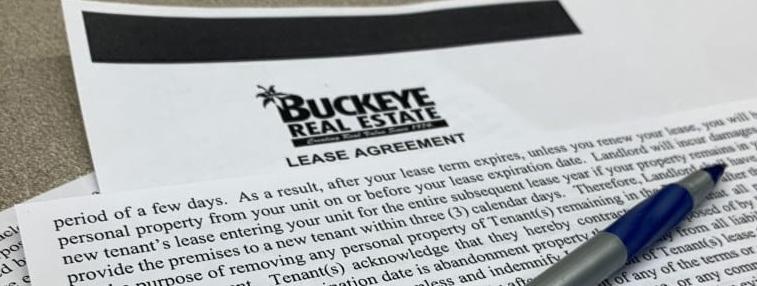
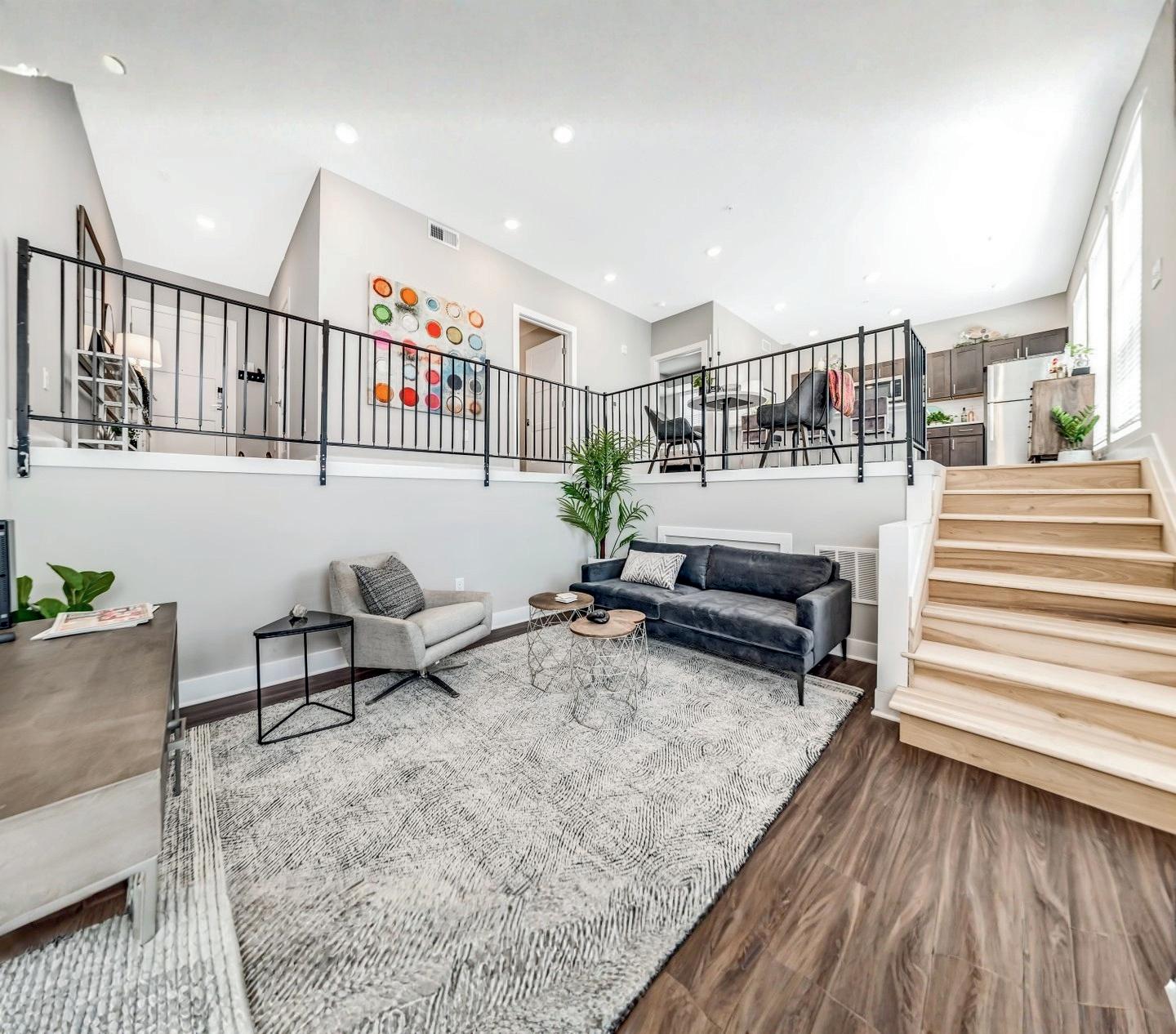



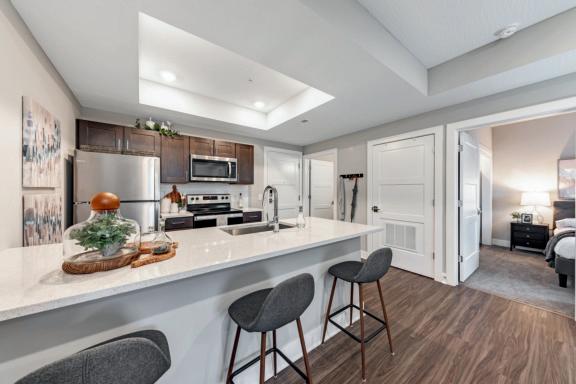
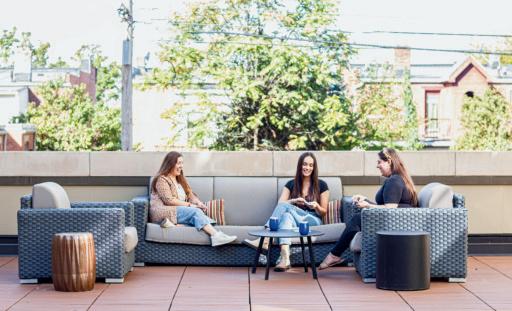
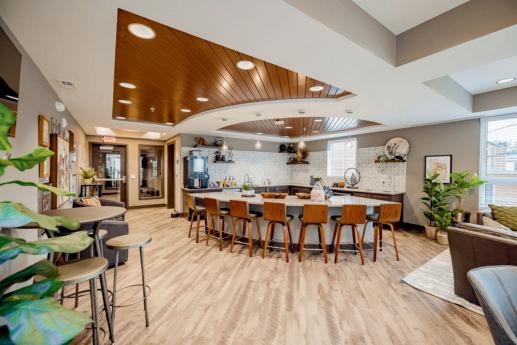

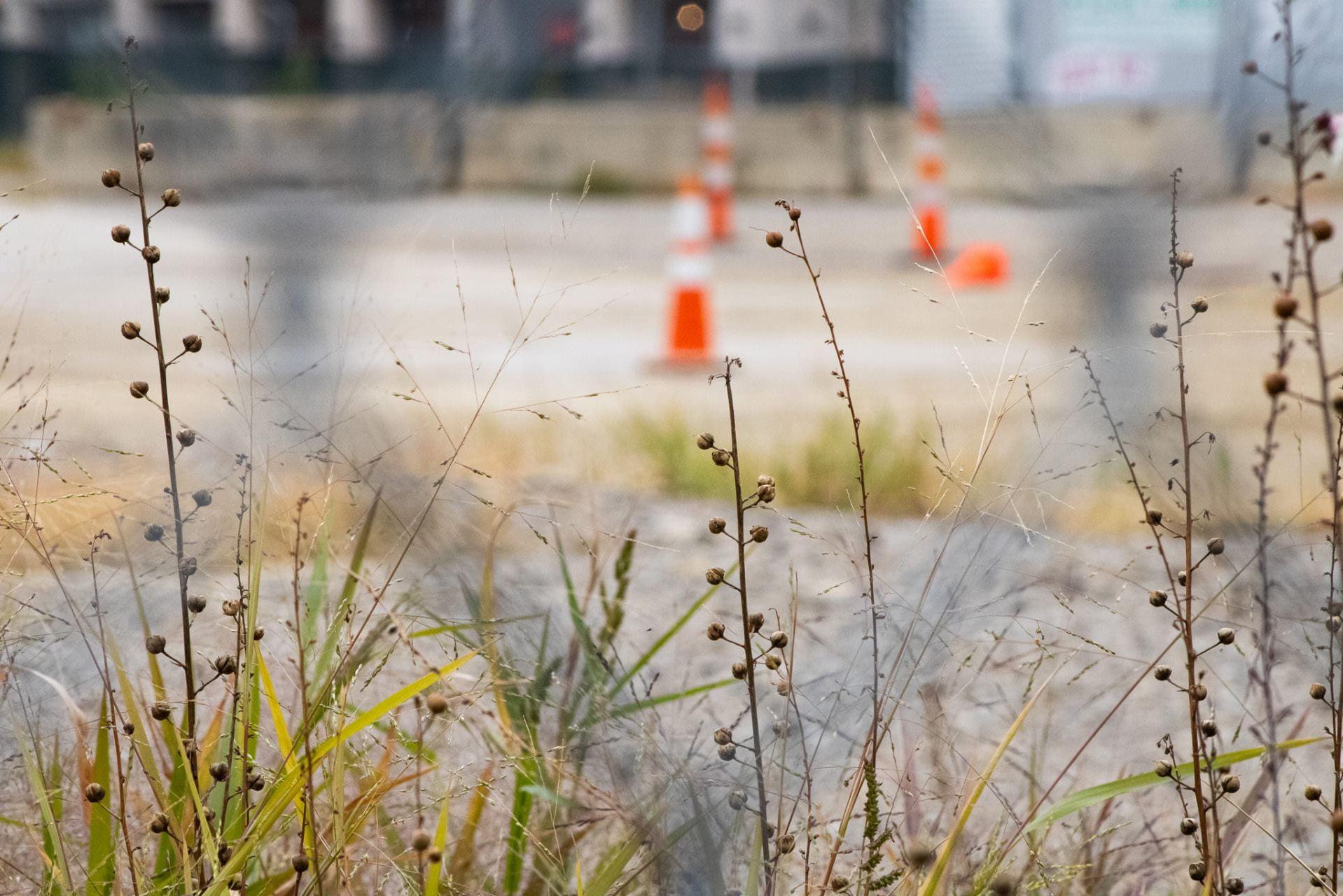
New complex with hotel, apartments in University Square set to move forward
Rayne James Lantern Reporter
Anew complex near Ohio State — combining a hotel, rooftop bar and apartment together — is expected to break ground in late fall 2026.
Located at the corner of Pearl Street and East 15th Avenue, east of the University Square, the building is planned to have 145 hotel beds and 120 apartments, according to a joint statement from Campus Partners and Crawford Hoying, a development company. On the ground floor, there will be new dining options in addition to the bar on the roof.
Campus Partners, a nonprofit branch of Ohio State’s development efforts, is known for its near-campus projects and submitted a rezoning application to the city of Columbus on Oct. 17.
“The applications submitted to the city are the first steps in bringing this vision to reality,” according to the statement.
In addition, there will be a parking garage that should offer up to 430 spaces.
“A signature hotel with new park-
ing options has been an important element of the plan for the University Square development from the beginning,” Rochelle Young, a public relations professional working with the project, said.
This upcoming project was originally part of construction plans that dated back to 2018, with plans to rezone the area into a mixed-use Commercial Planned Development District, per prior Lantern reporting.
With plans to further advance this project, the building would be a 12-16 story complex, 16 if affordable housing units are included in the plans, according to the City of Columbus’ Zone In initiative.
The proposal will next be shared with the University Area Commission in order to give recommendations to Columbus City Council on further advancements, according to a report from the Columbus Dispatch.
Perks of living off-campus
Continued from page 2.
University District
As the heart of Ohio State’s off-campus community, the University District is full of energy, creativity and student life. The area’s mix of long-term residents, students and artists gives it a diverse, expressive atmosphere that reflects Ohio State’s spirit.
Local projects and initiatives, such as community art programs and live events like the Pearl Alley Jam, showcase the district’s commitment to creativity and connection, according to the University District website.
Lydia Dougan, a third-year in health and rehabilitation sciences, said she chose to live in this district because of its accessibility and hous ing availability.
“I knew a majority of my classes would be located close to South Campus,” Dougan said. “As I would have preferred to live toward North Campus, I had a difficult time finding available housing along with affordable options.”
Despite those drawbacks, Dougan said transportation and access to stores are convenient.
“I have great options regarding transportation, I can walk, bike, drive, take a COTA bus or even a campus bus,” Dougan said. “There are numerous grocery stores within a mile, so thankfully I don’t live in a food desert.”
German Village and Brewery District
Just south of downtown, German Village offers one of Columbus’ most picturesque neighborhoods. The neighborhood’s cobblestone streets, brick homes and cozy coffee shops give it a small-town feel just minutes from campus.
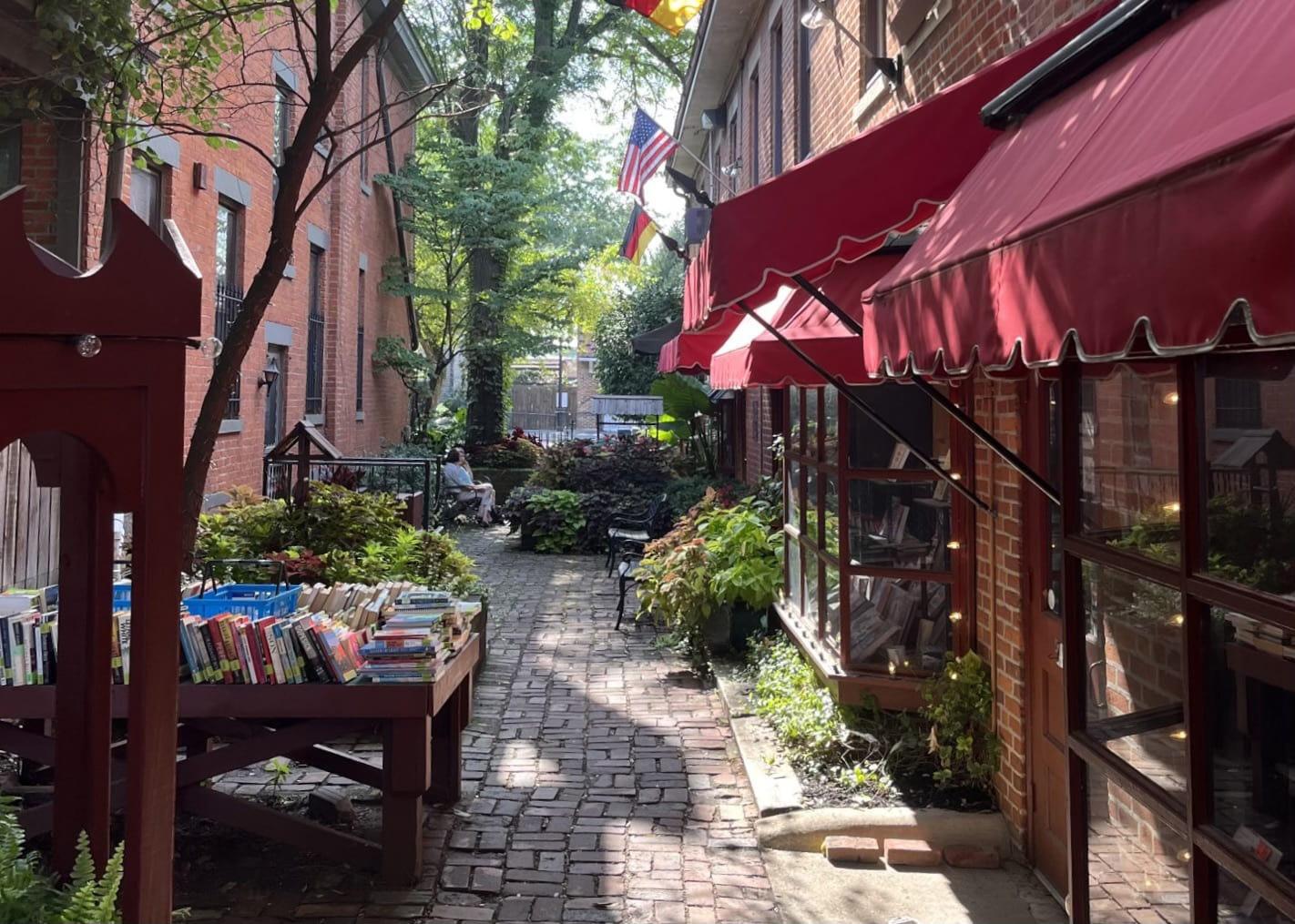
Students who choose to live here can enjoy local favorites like The Book Loft, free summer performances at Schiller Park and quiet afternoons at neighborhood cafés.
She described the area as busy and tight, with old and new buildings mixed together.
“One street you feel safe and the next you don’t,” Dougan said. “If I had to describe the area in one word, I’d say ‘gentrified.’”
Though she likes the location, Dougan said there’s room for improvement when it comes to safety and parking.
“I don’t always feel safe, the parking and one-way streets are a nuisance, and it doesn’t feel homey,” Dougan said. “I think there could be a better presence of streetlights, security, police or cameras.”
Nearby, the Brewery District blends that old-world charm with modern nightlife, featuring popular bars, restaurants and Shadowbox Live, the nation’s largest resident theater company.
Together, the two neighborhoods offer a mix of history, entertainment and culture for students looking to experience Columbus beyond the University District, according to the Experience Columbus website.
No matter what students are looking for, arts and nightlife, historic charm or easy access to campus, Columbus’ off campus neighborhoods provide something for everyone. Choosing the right district can make a student’s college experience feel a little more like home.
The lot off Pearl Street & East 15th Avenue on Wednesday.
DANIEL BUSH | CAMPUS PHOTO EDITOR
German Village.
